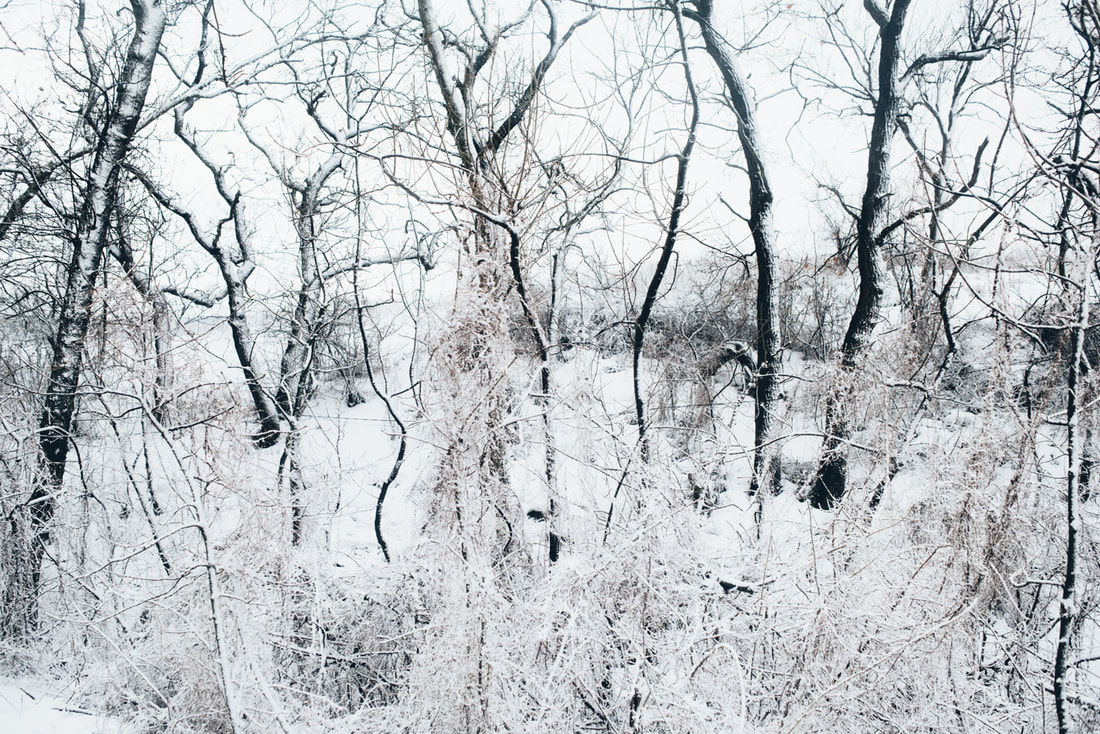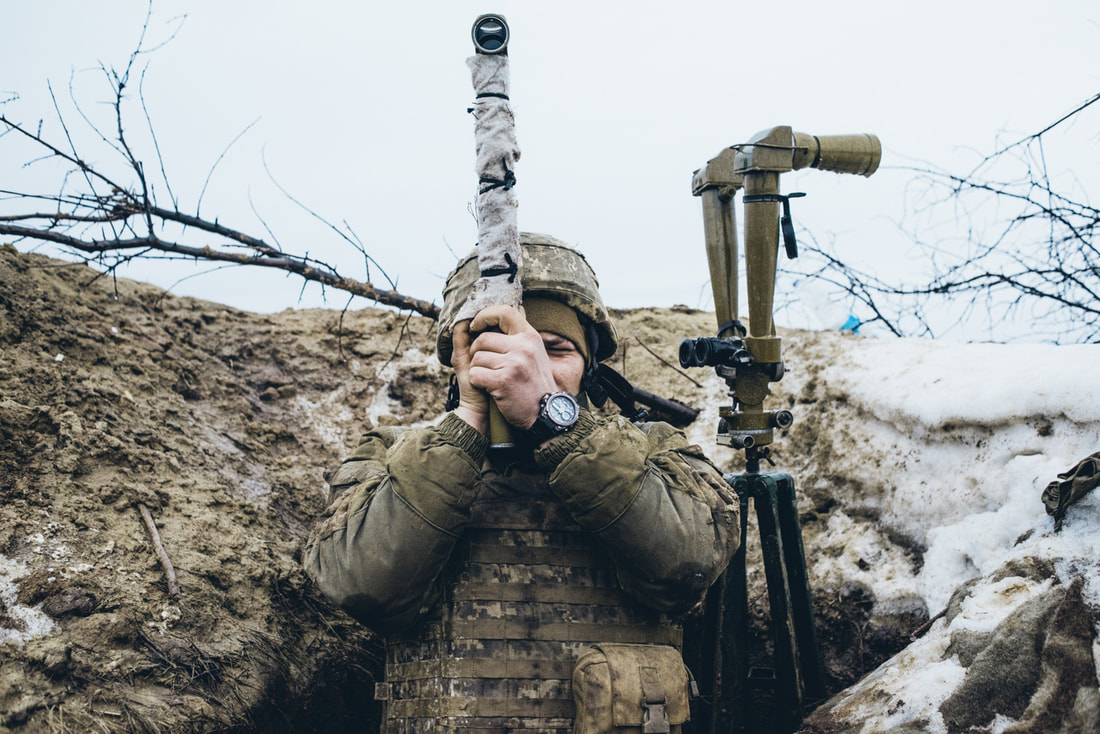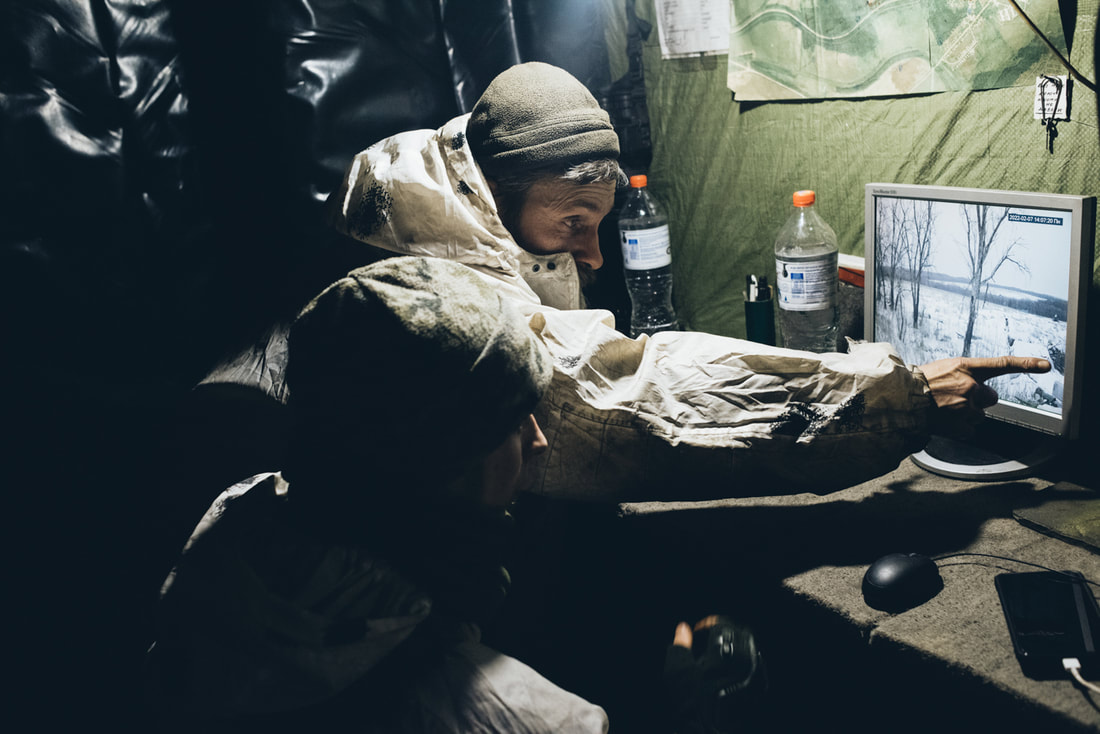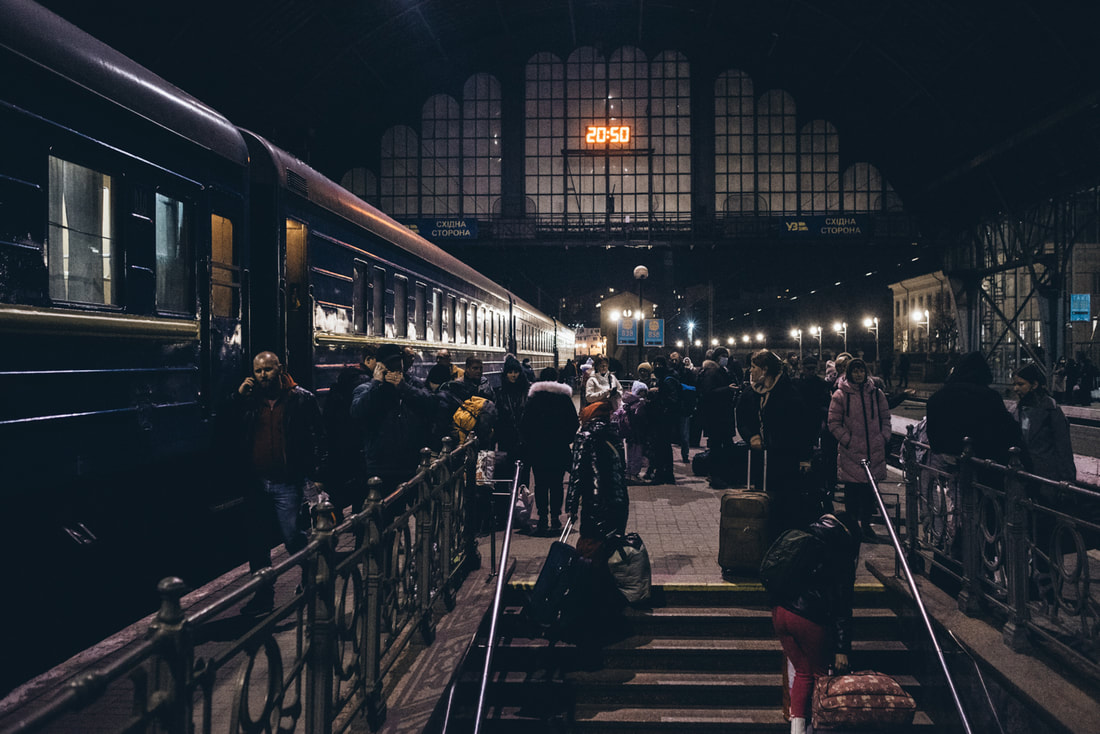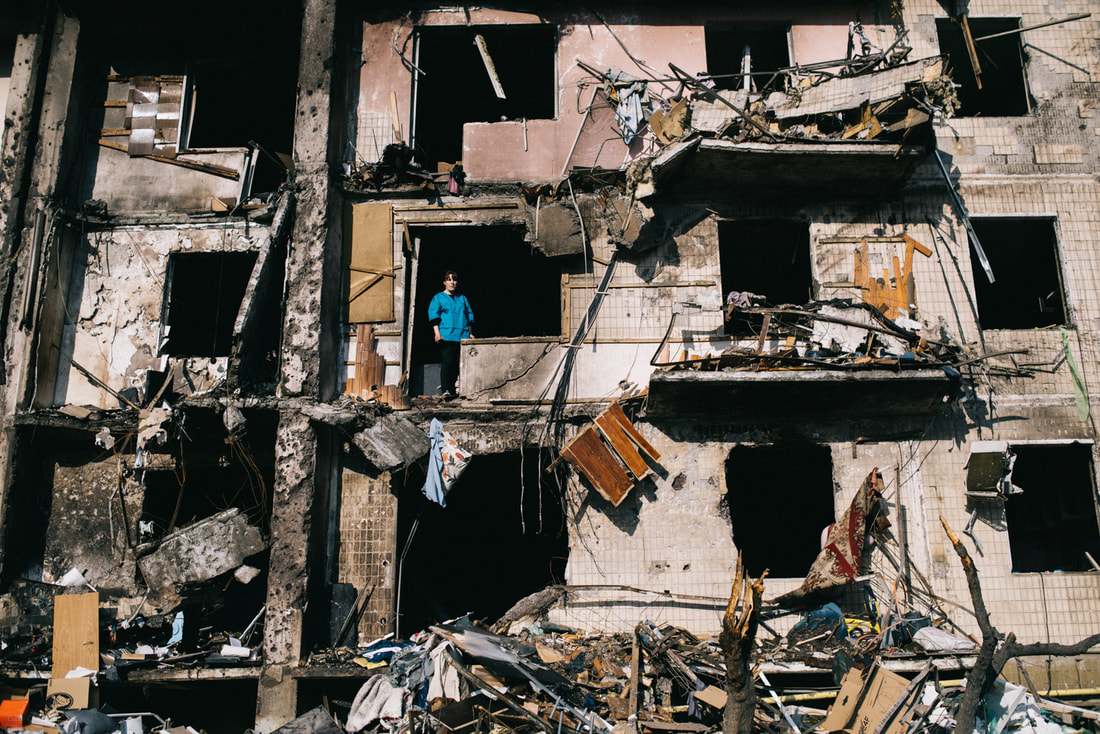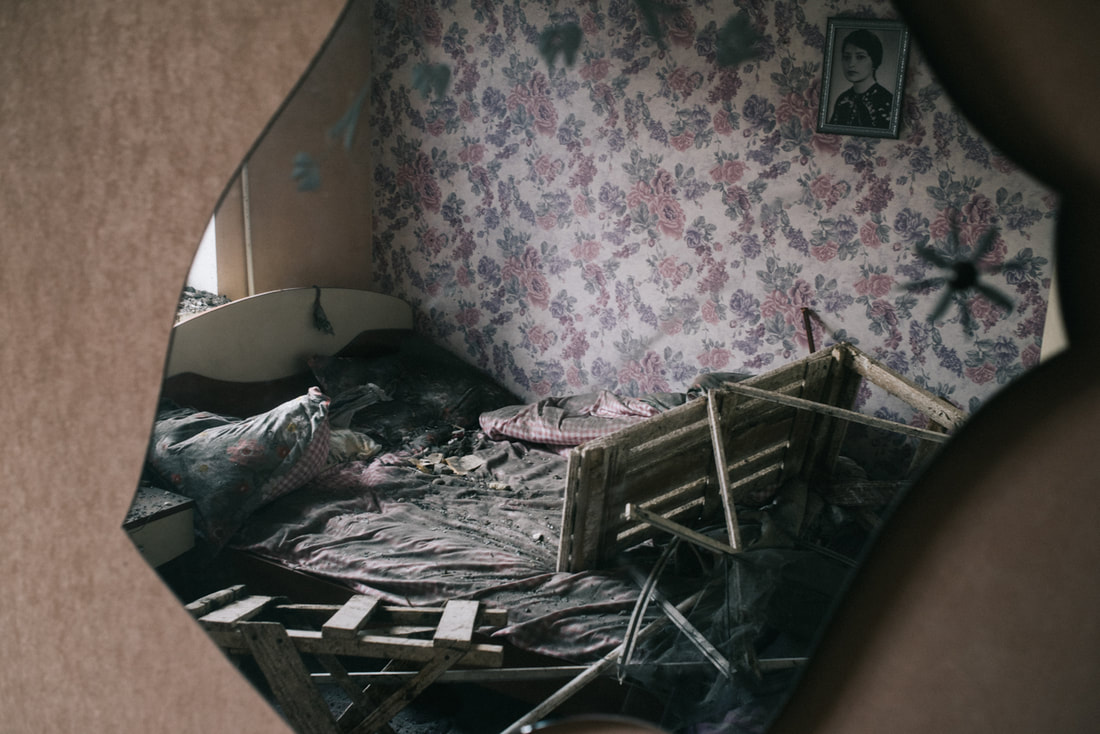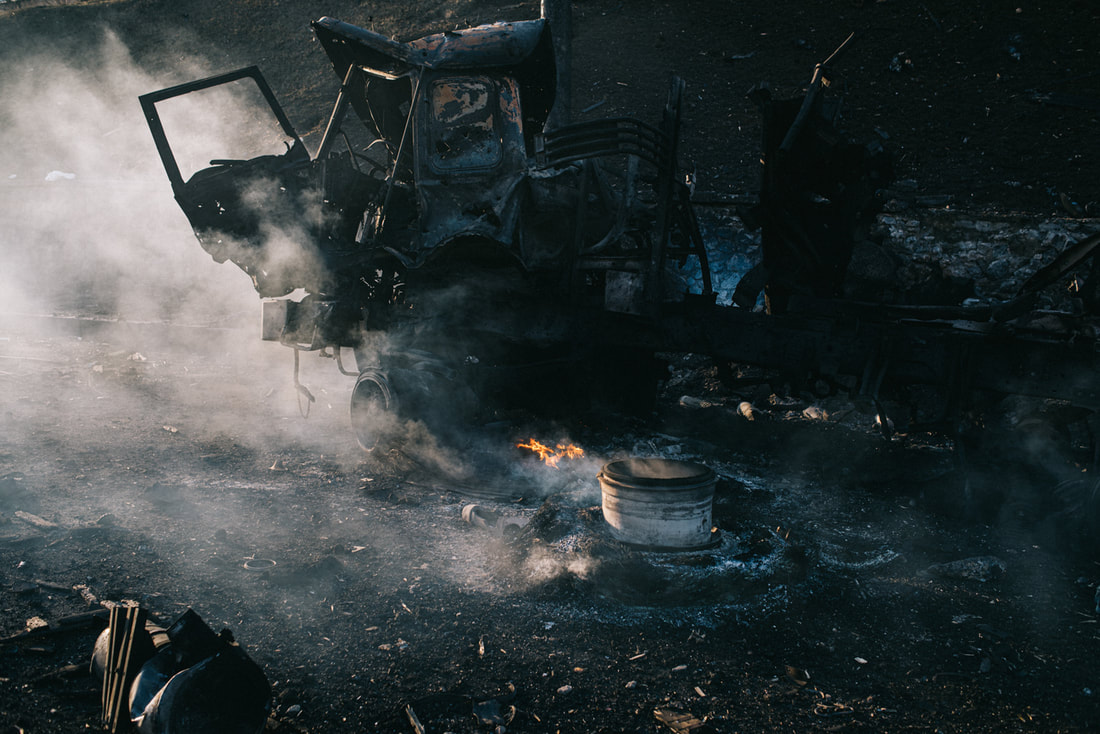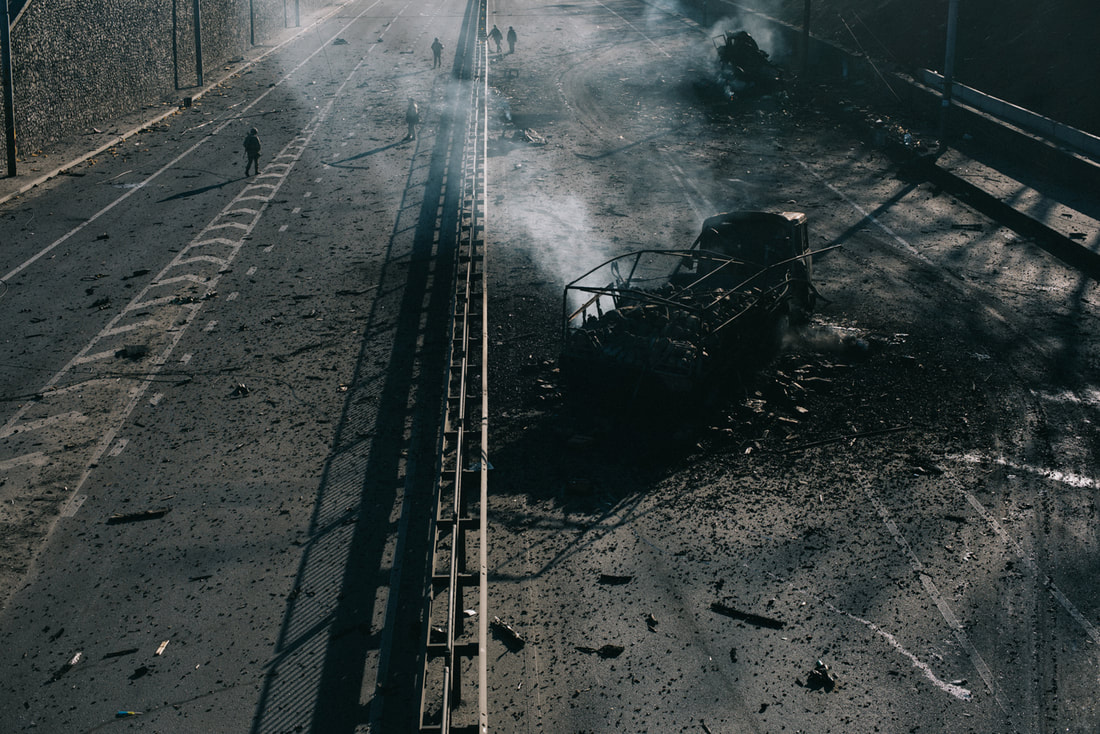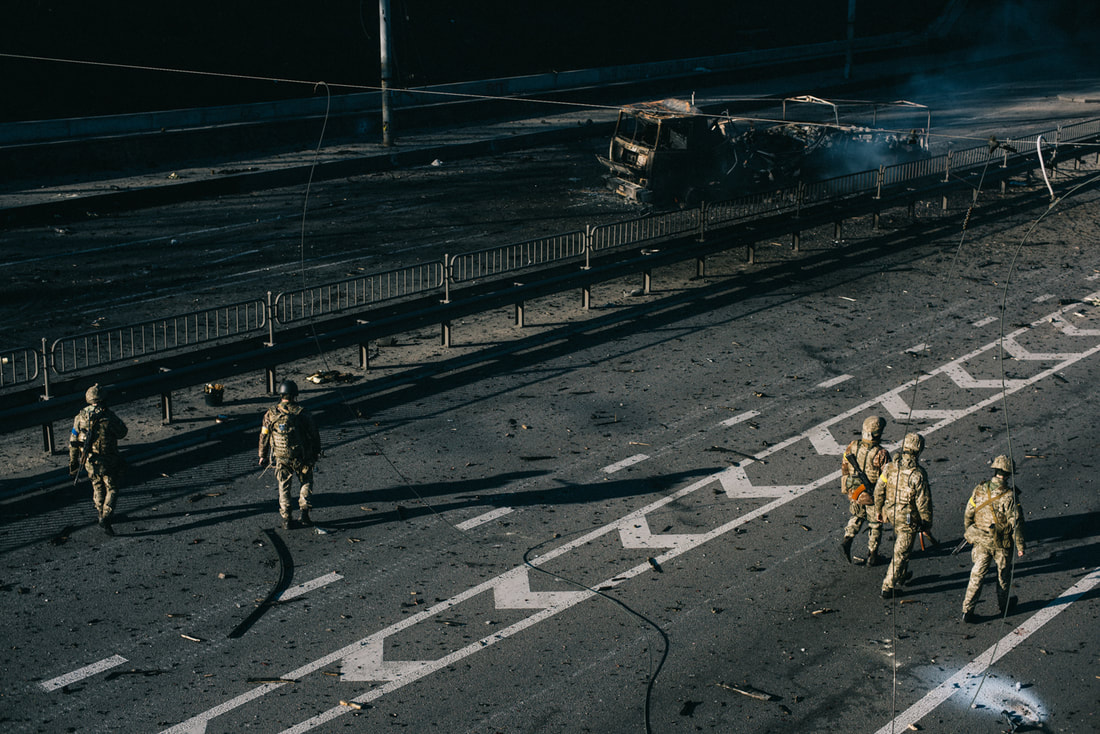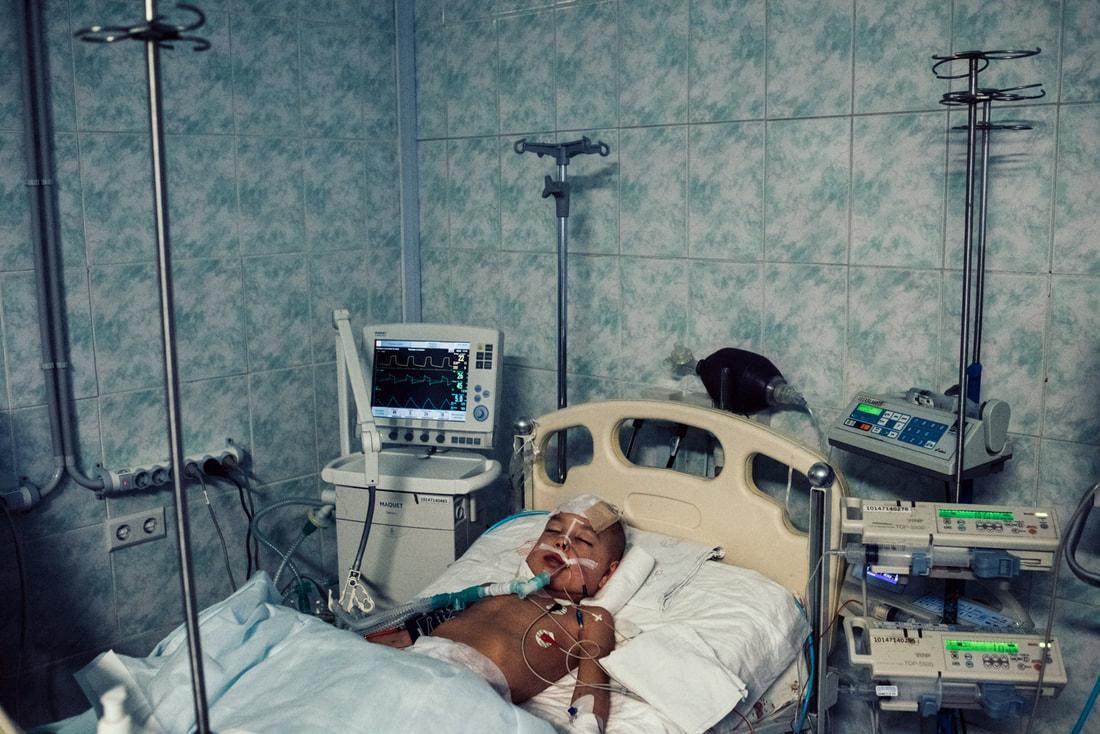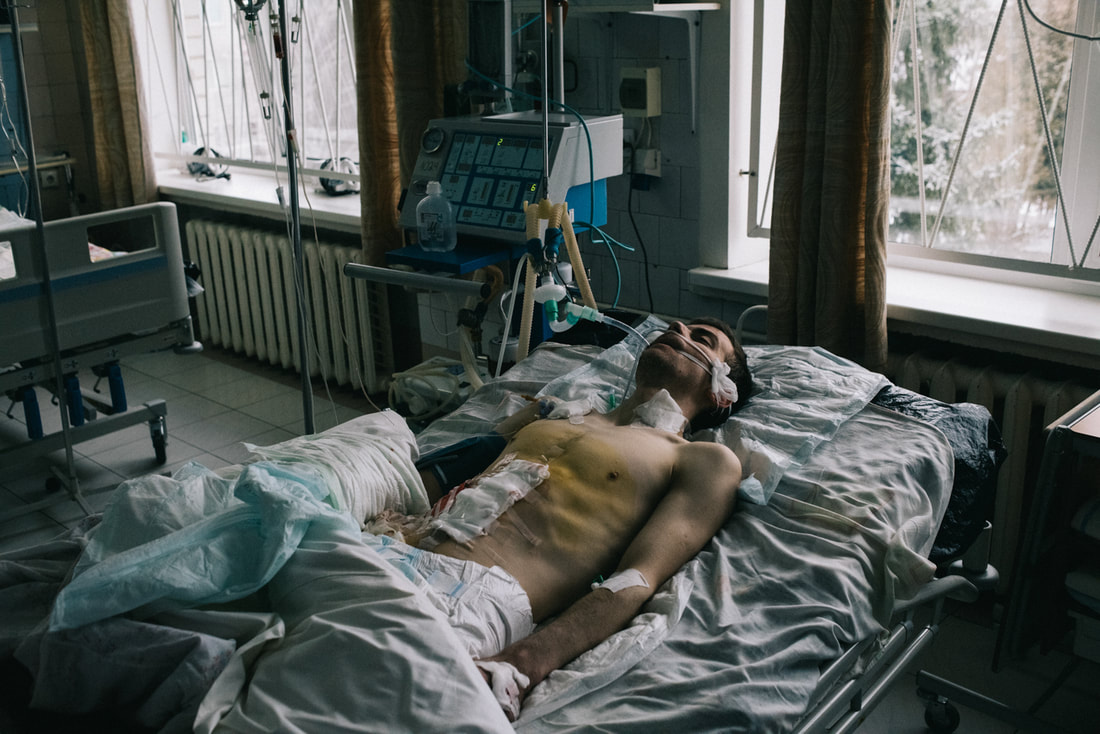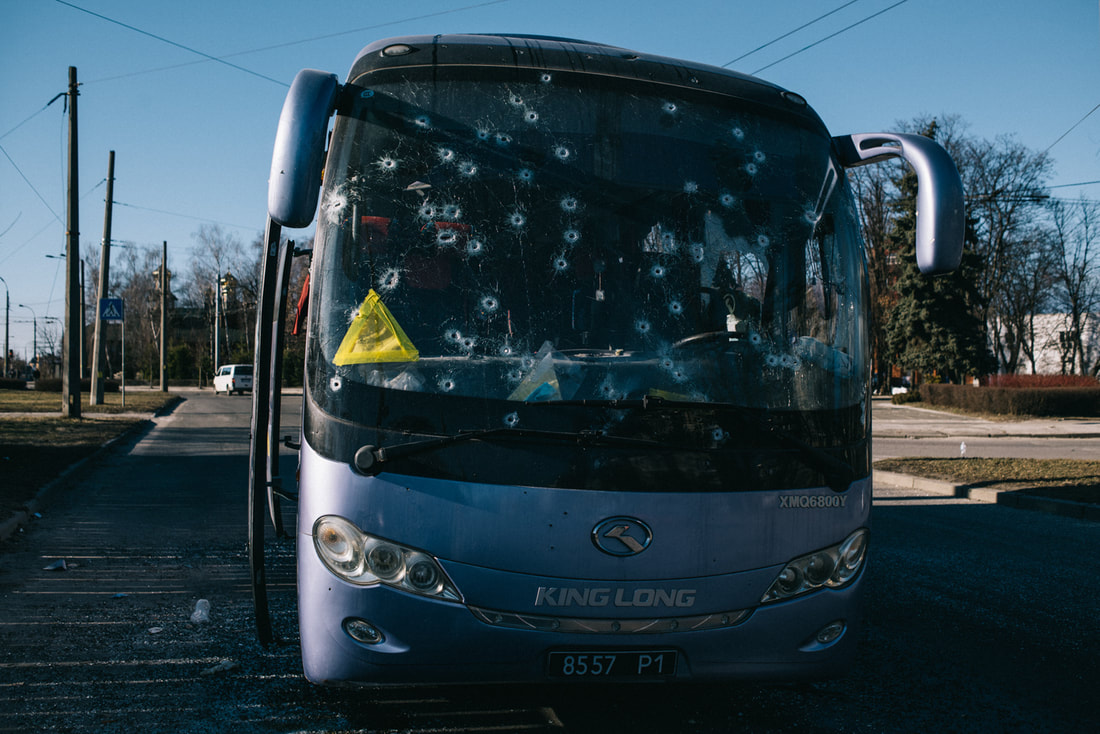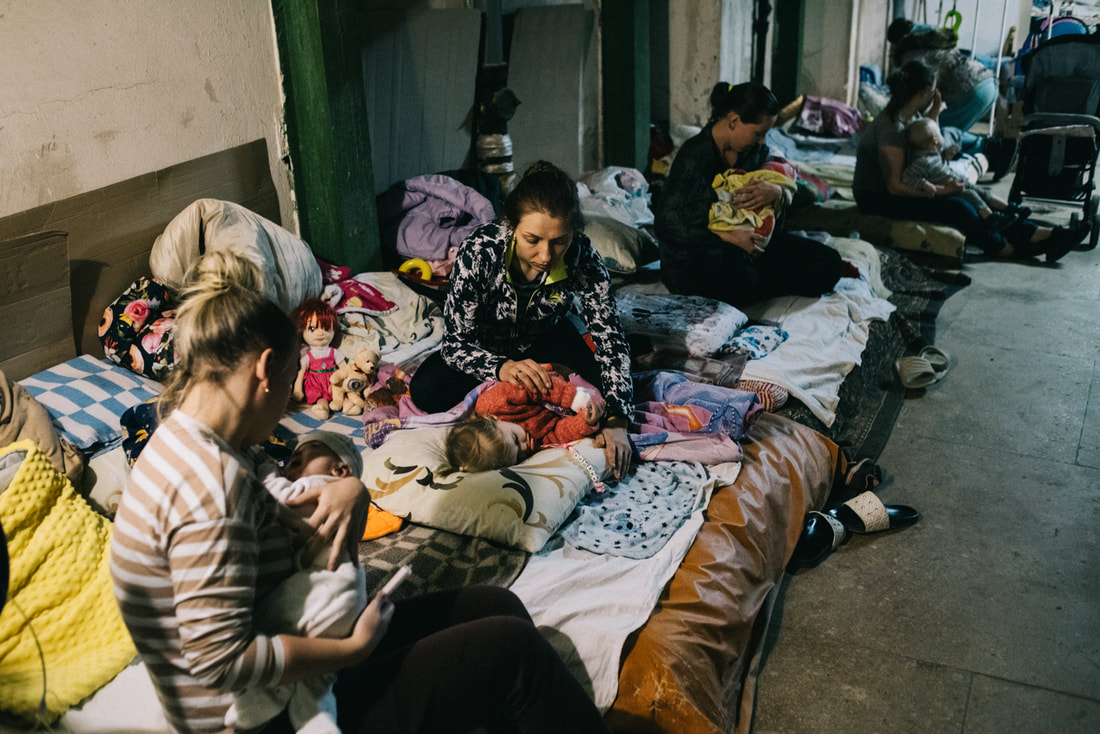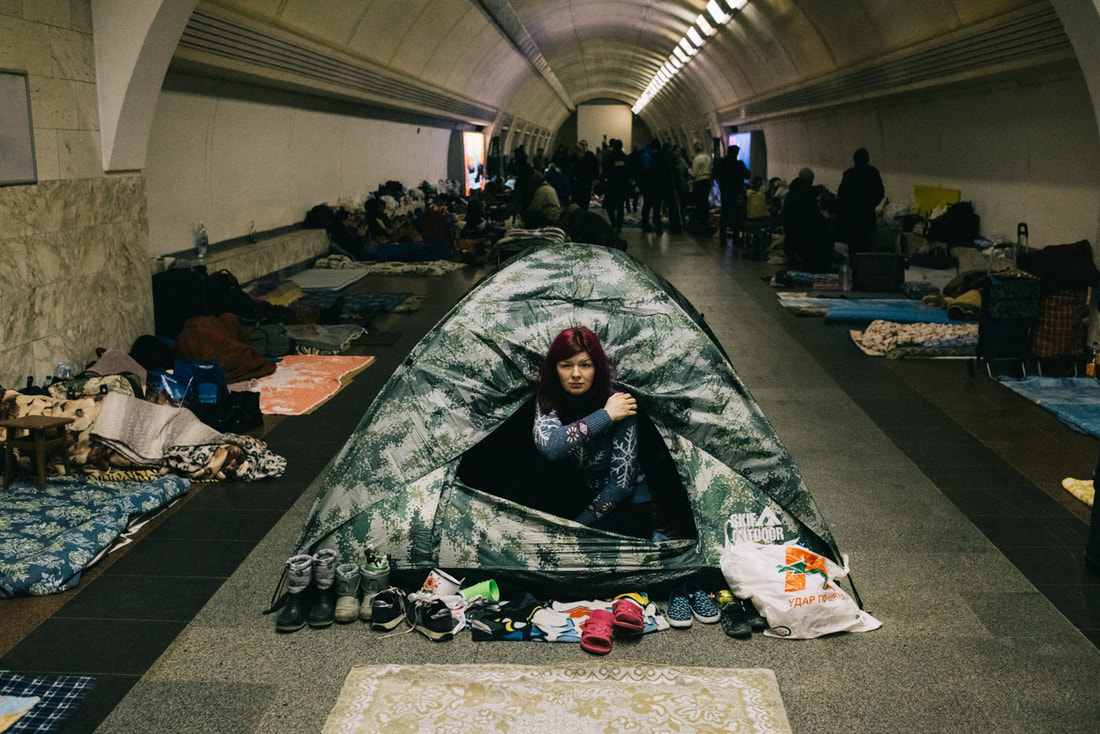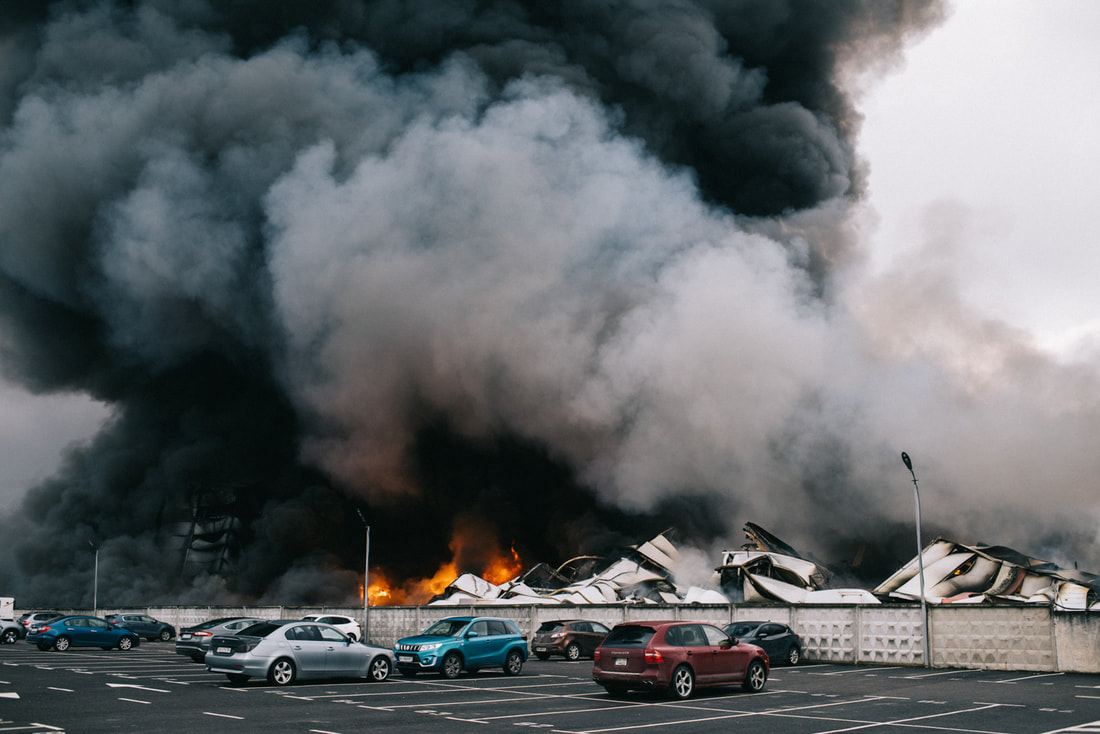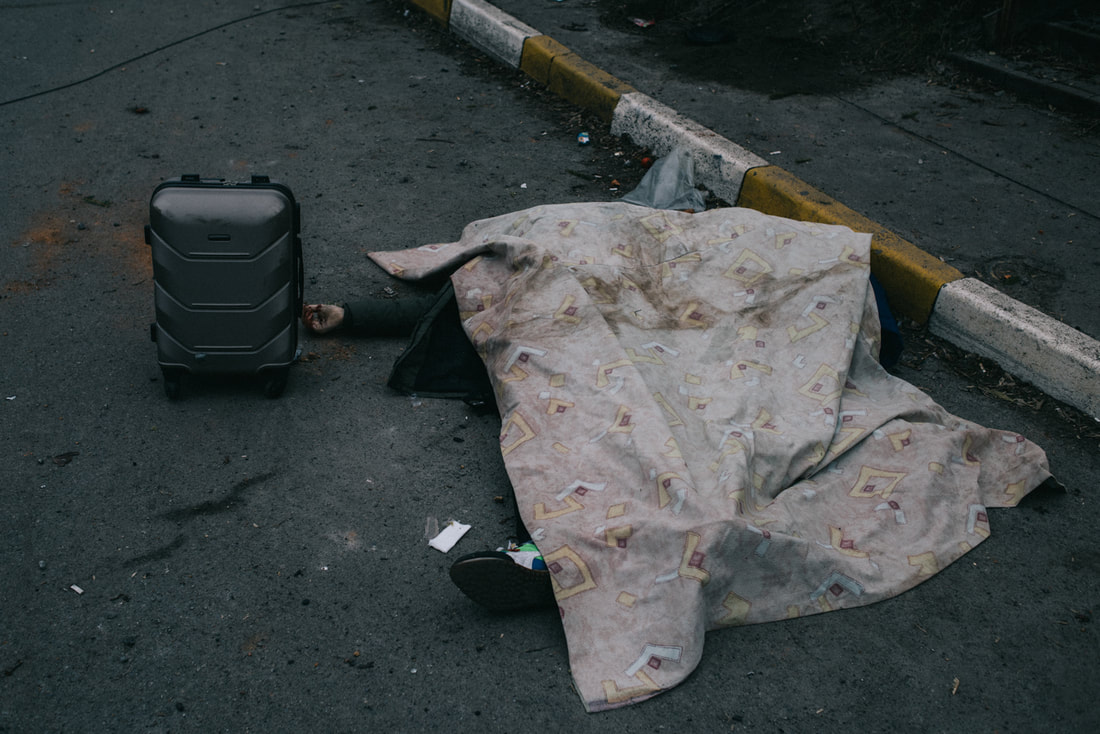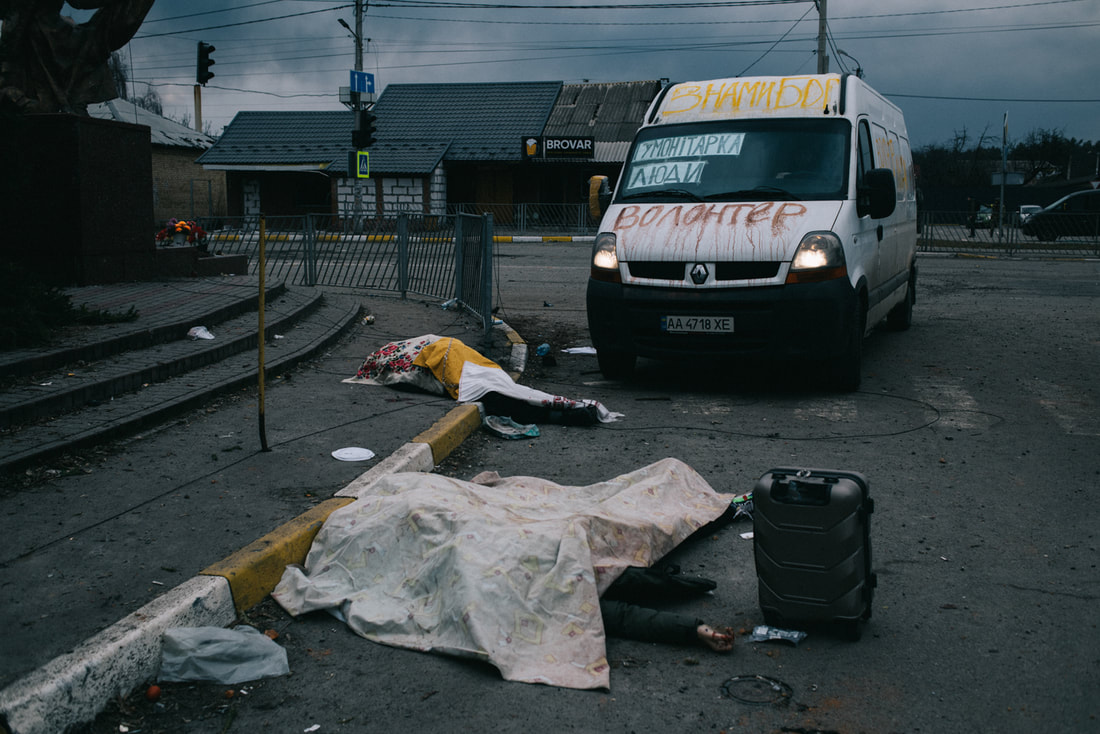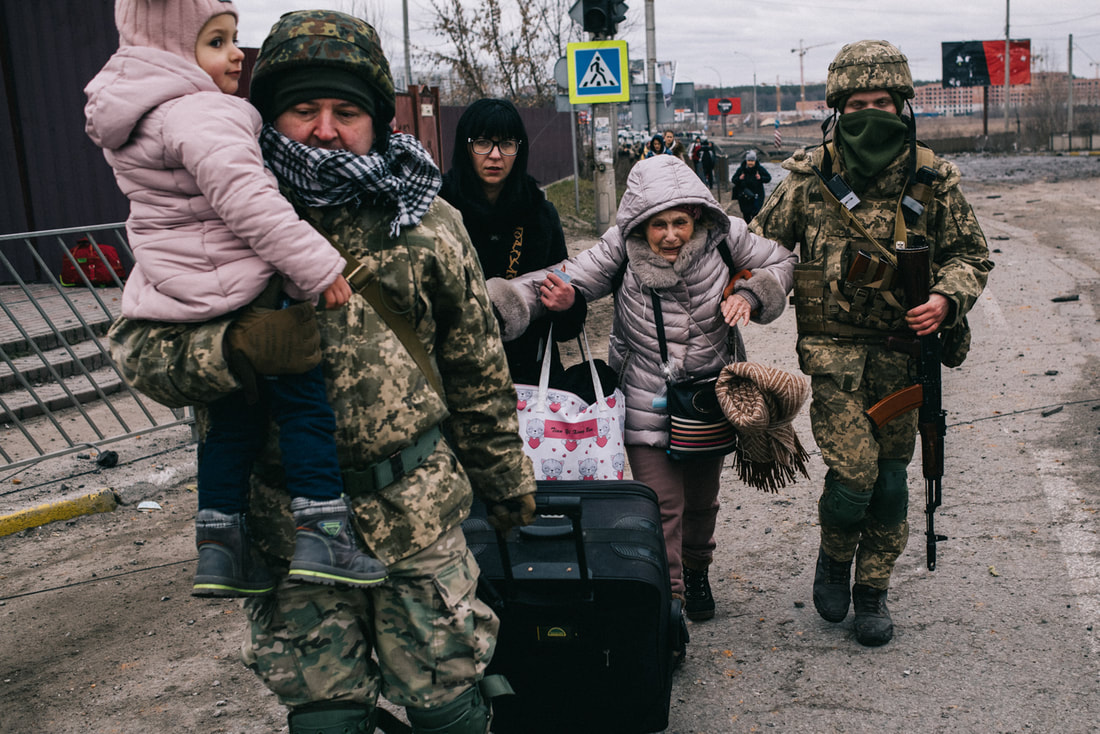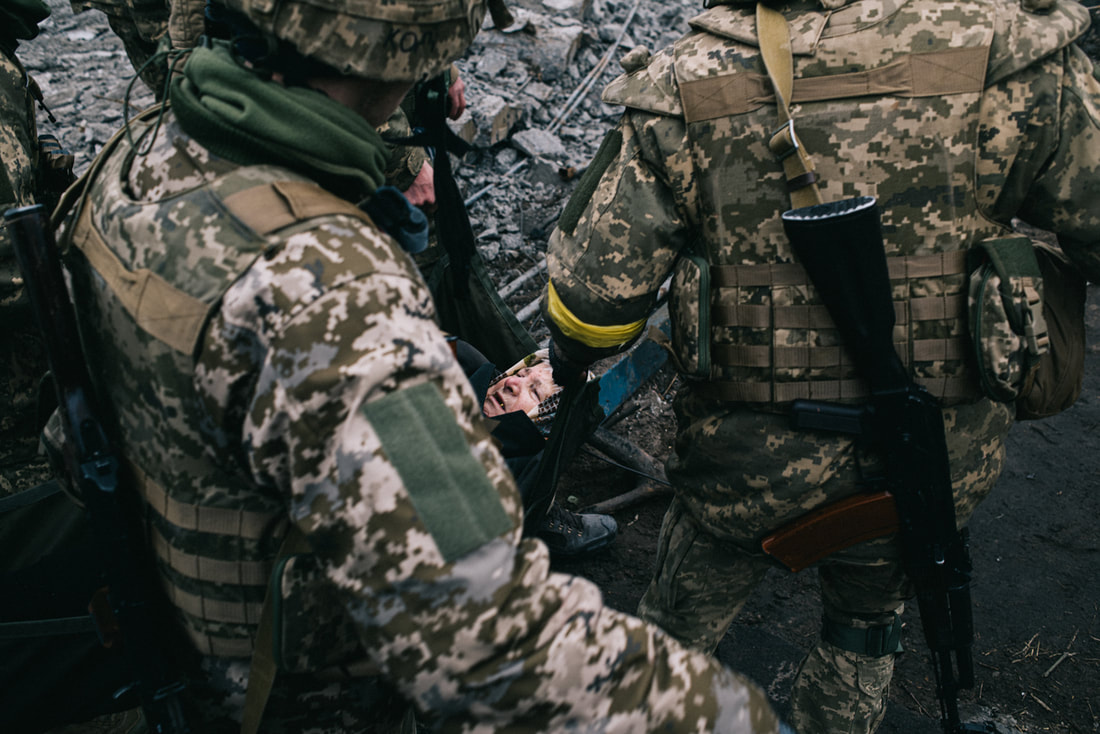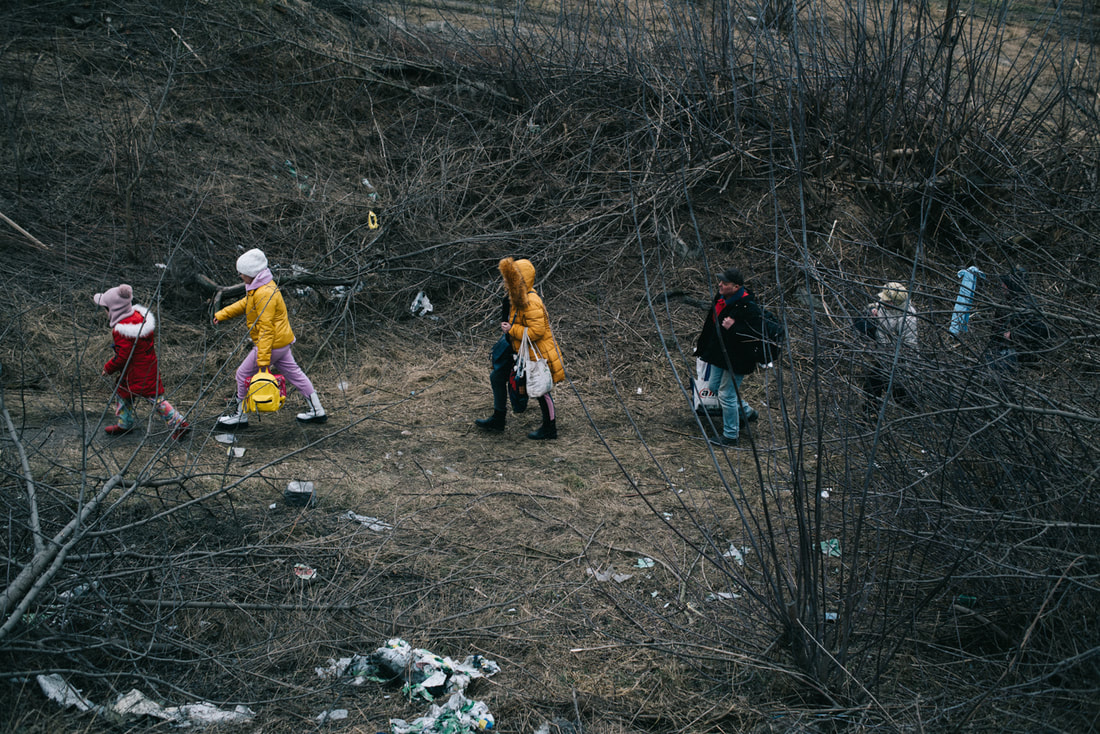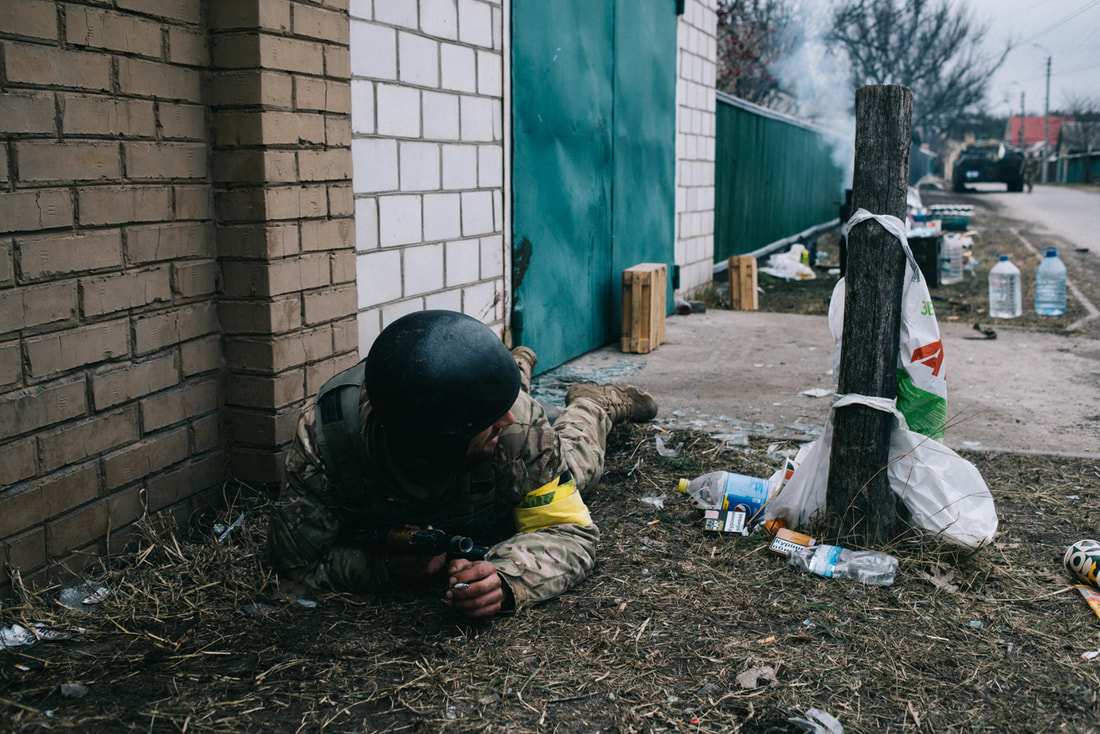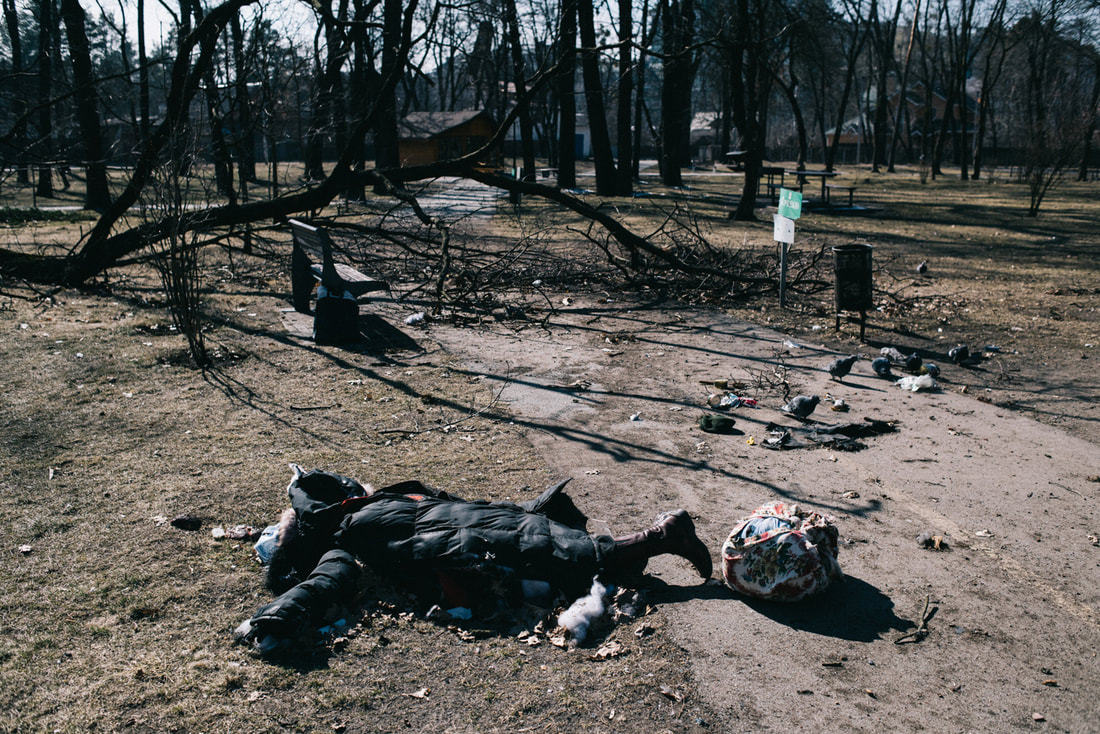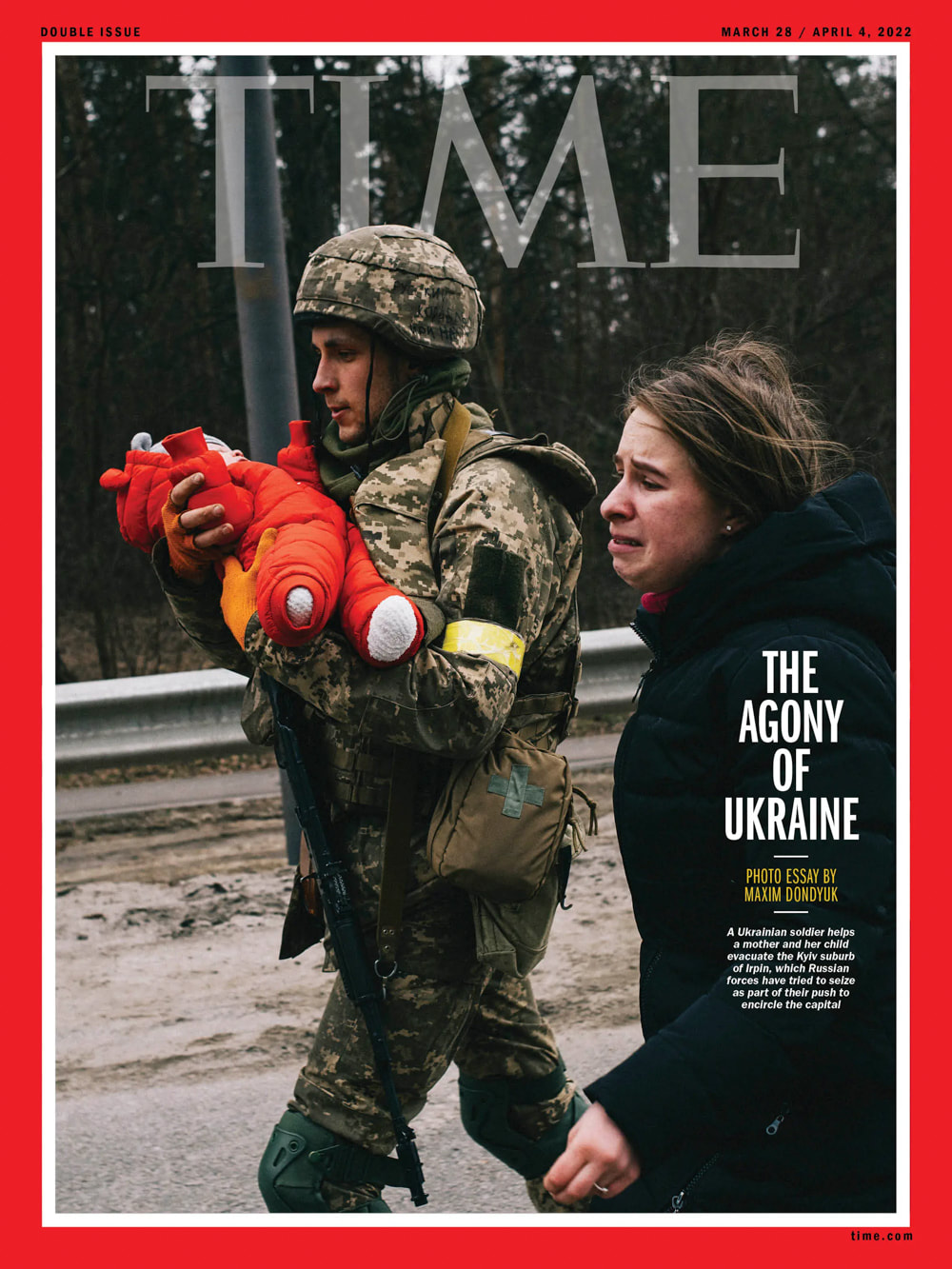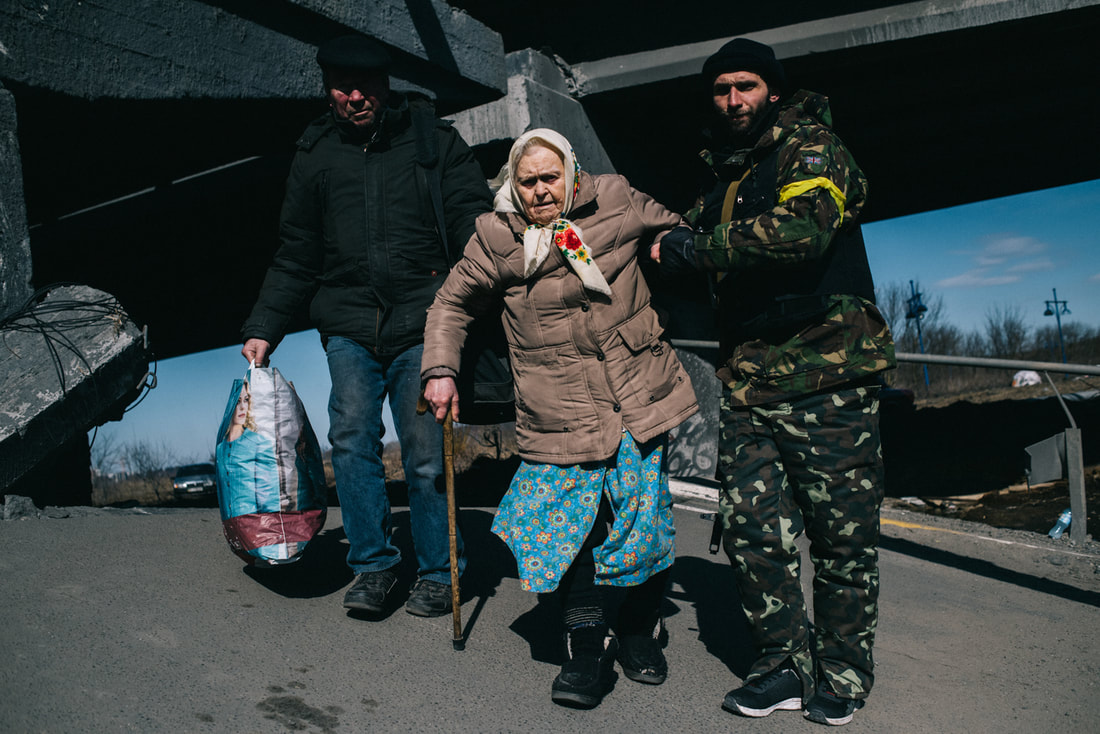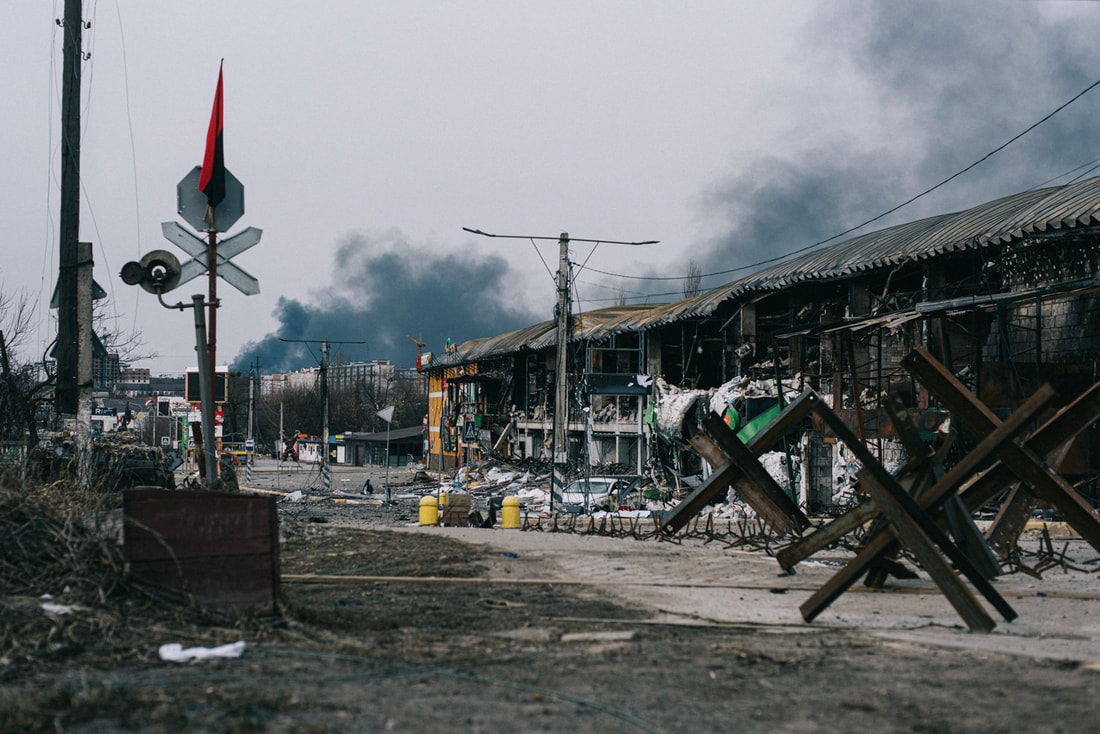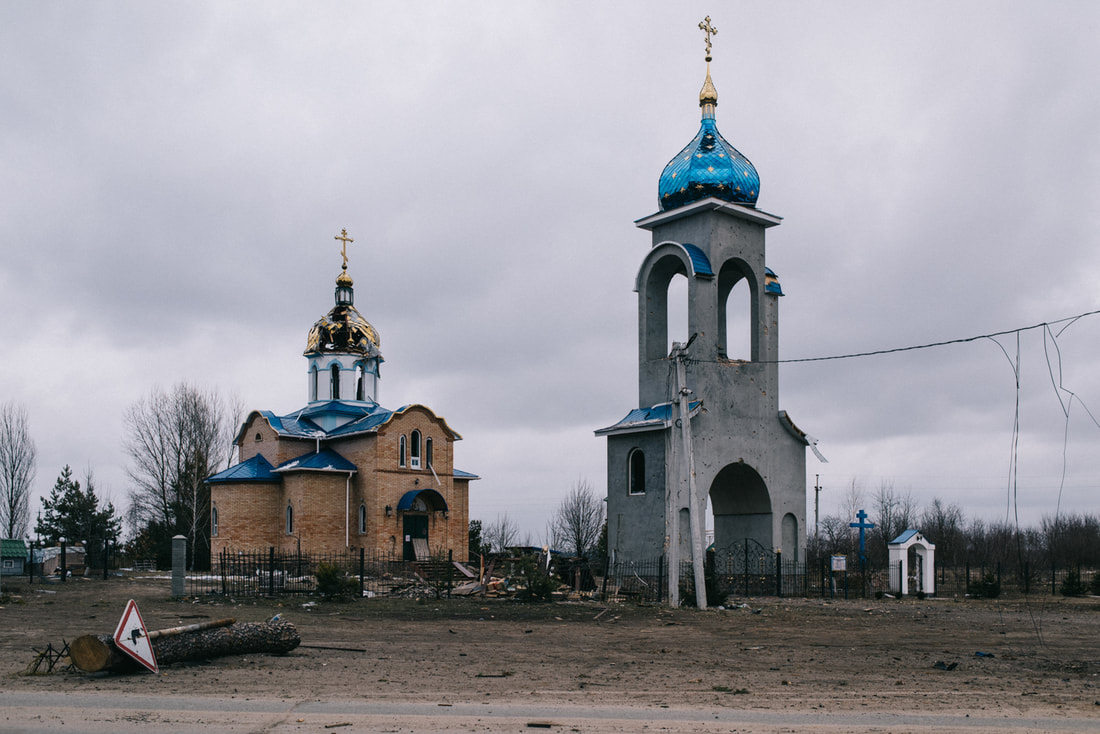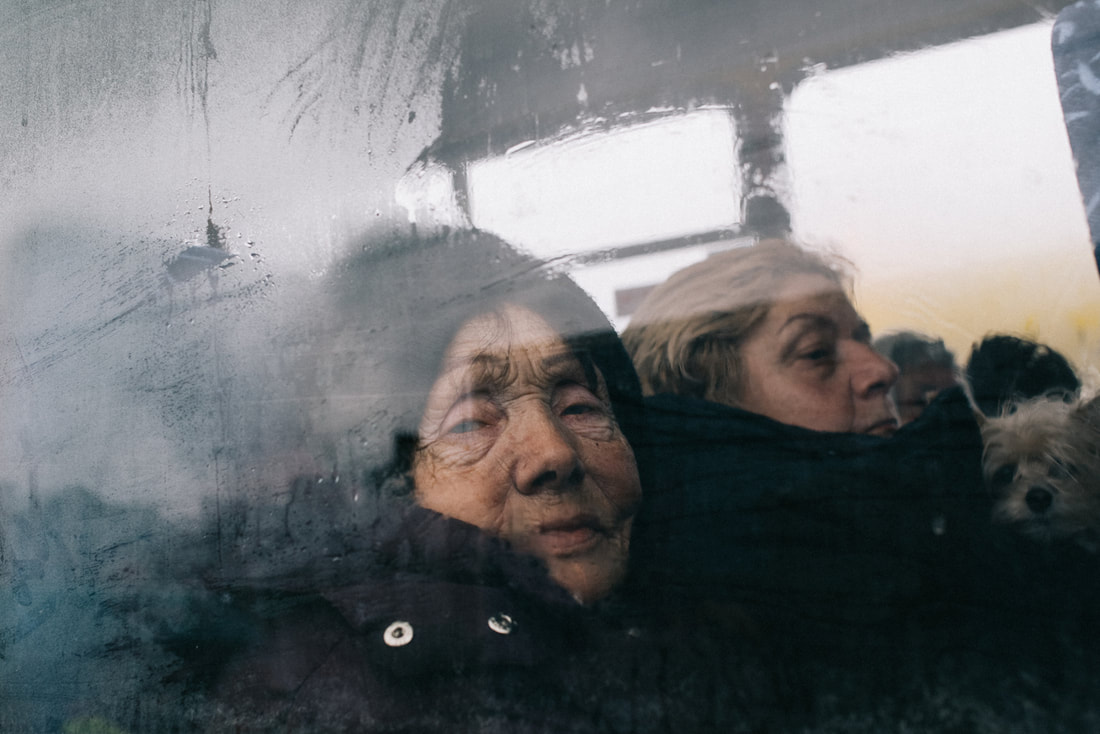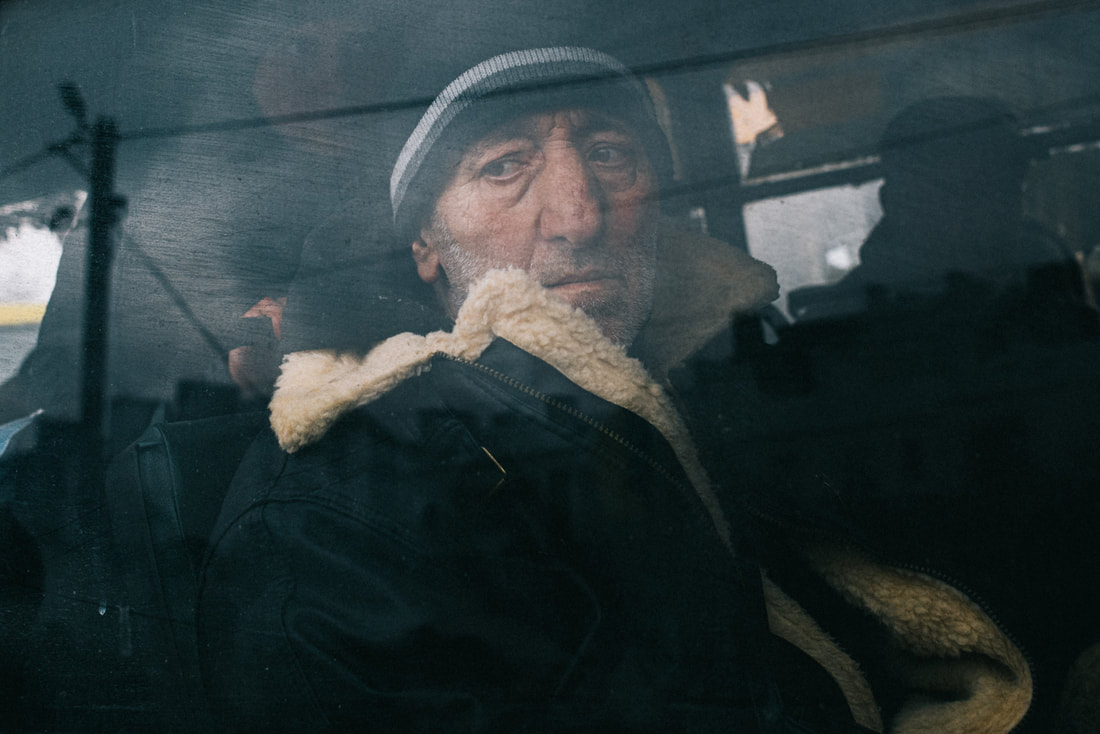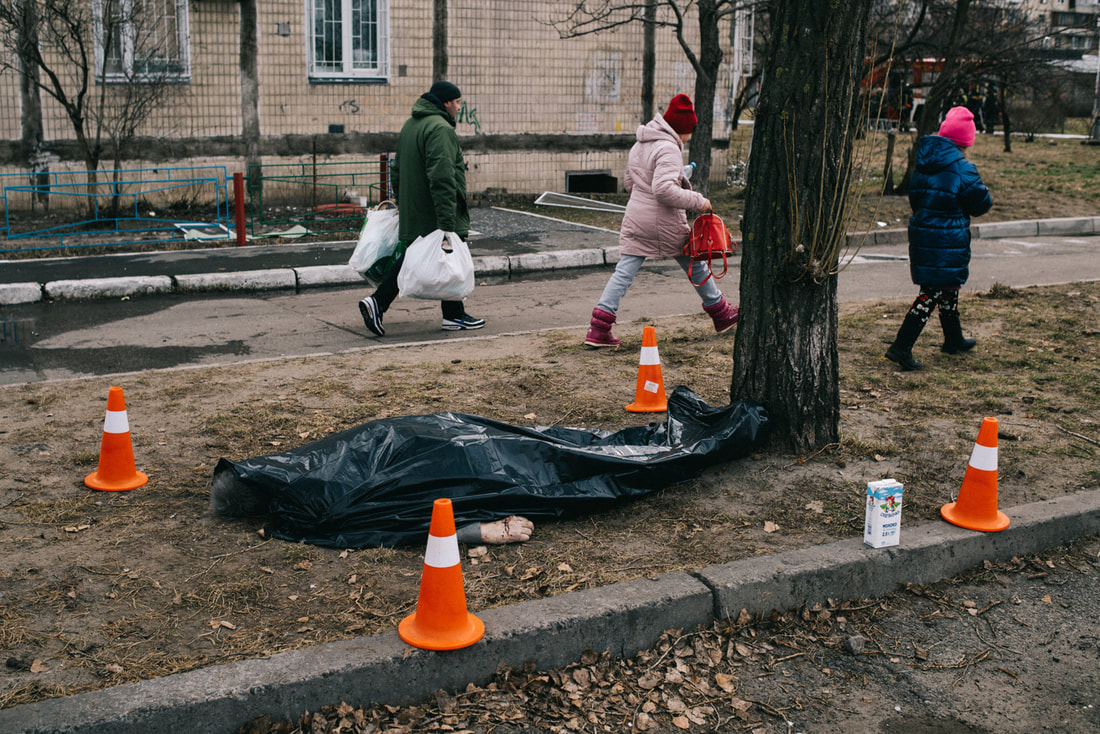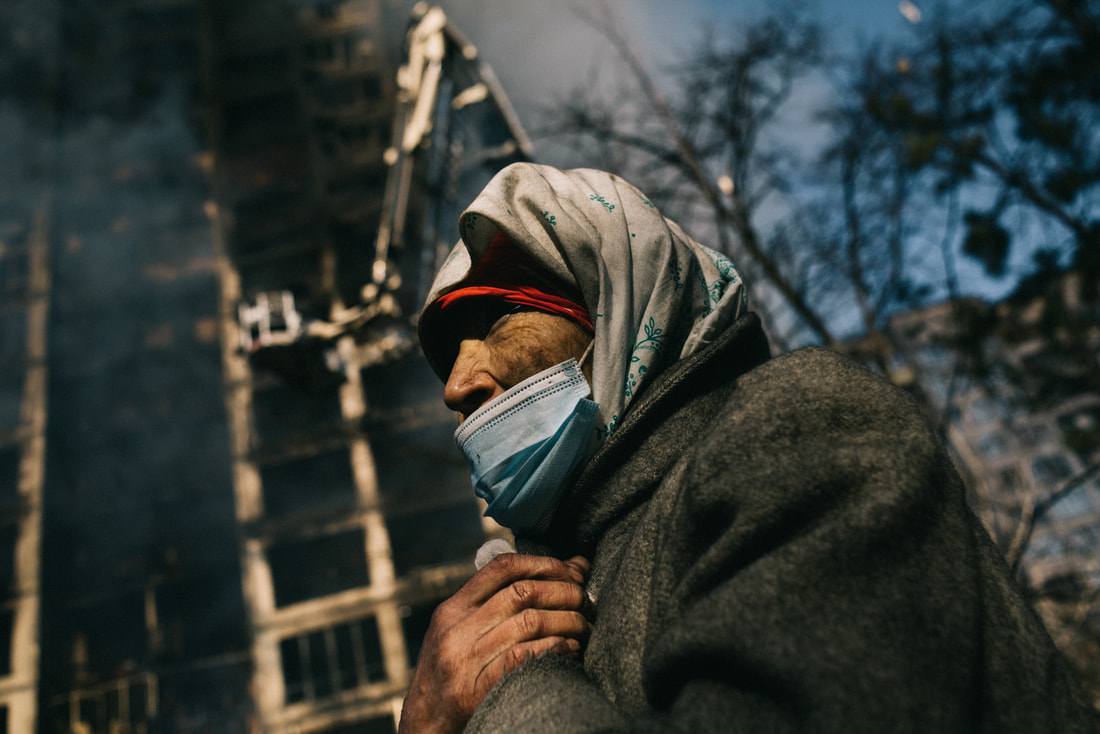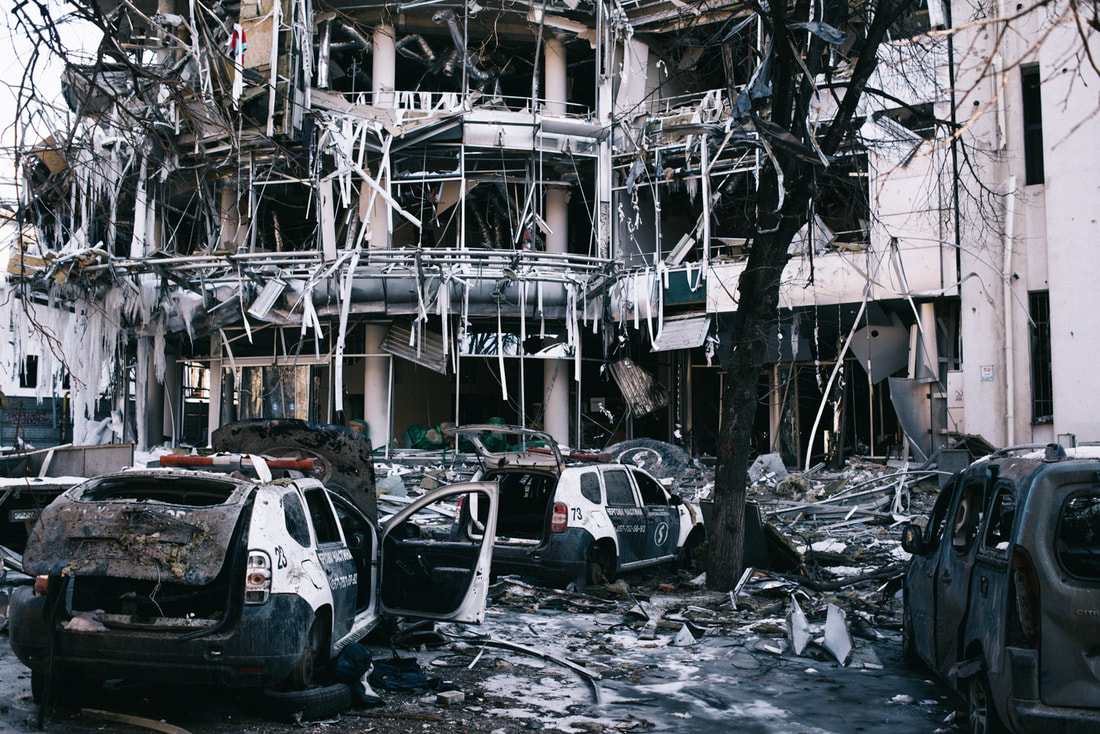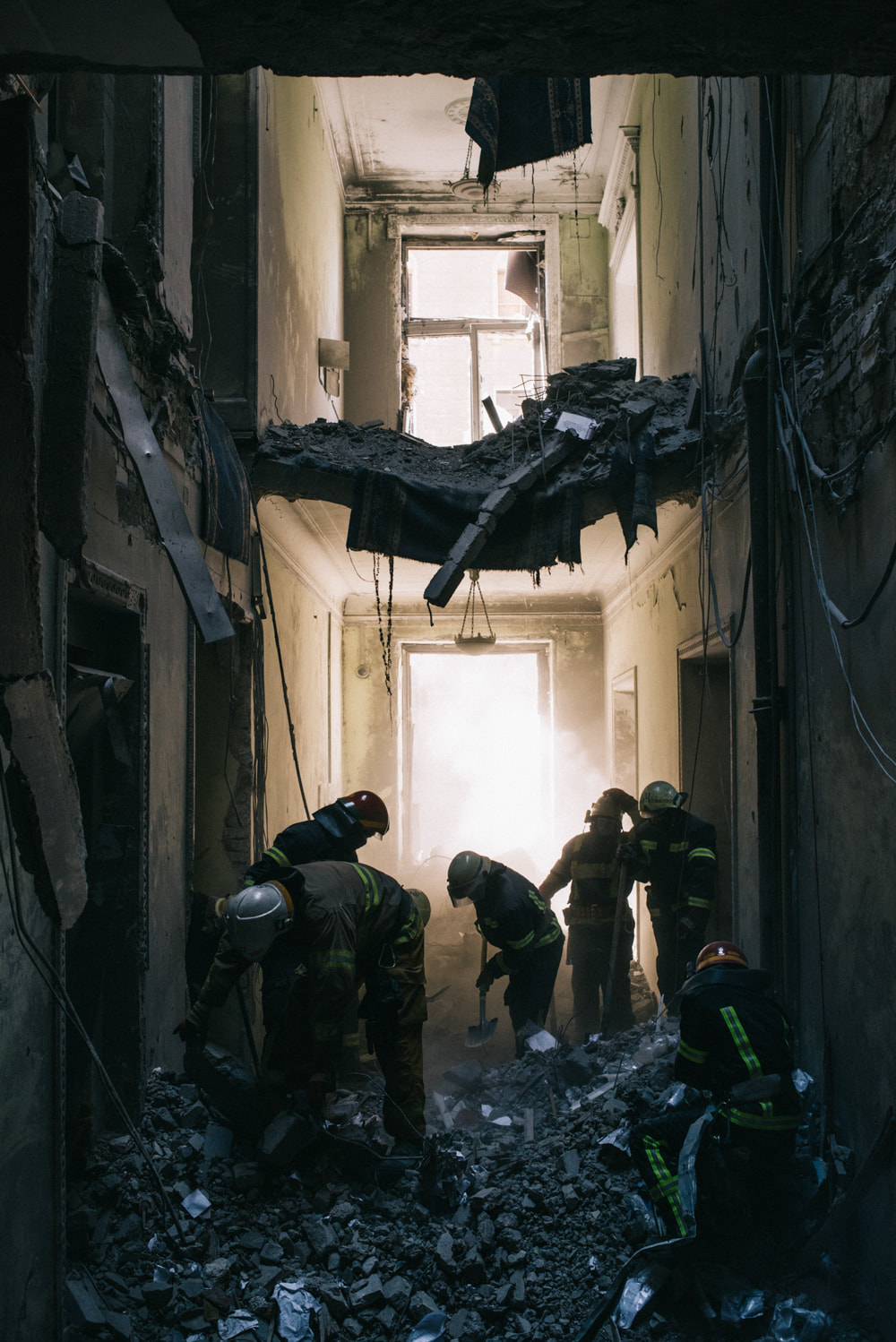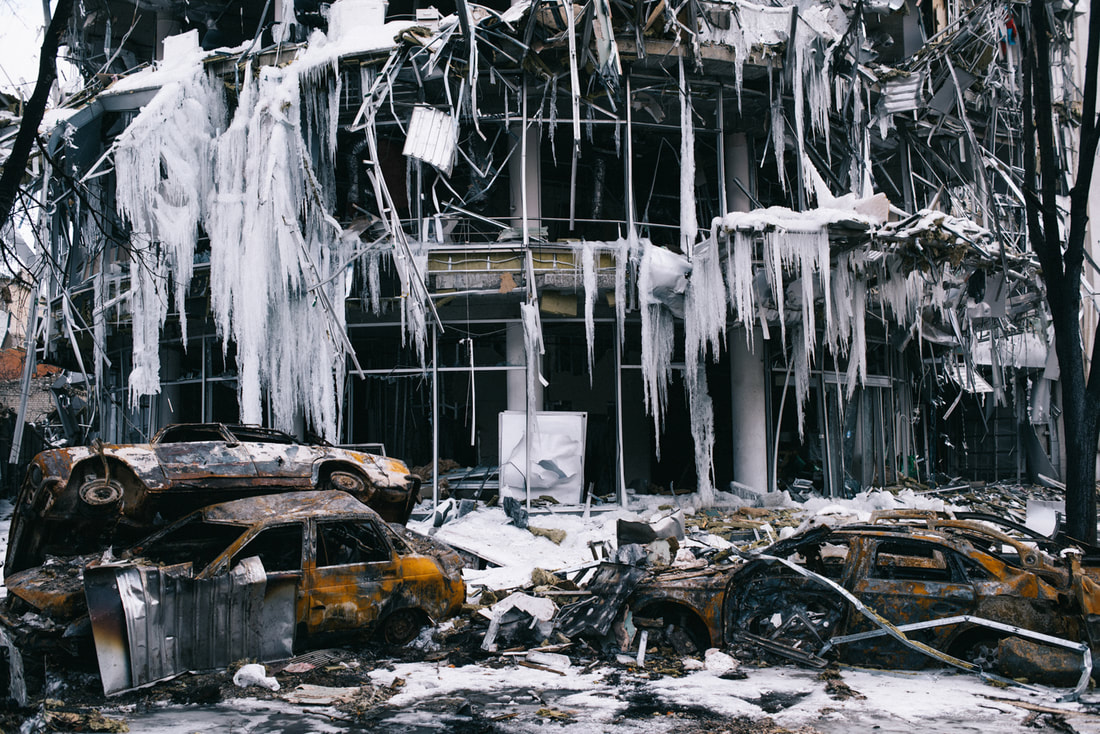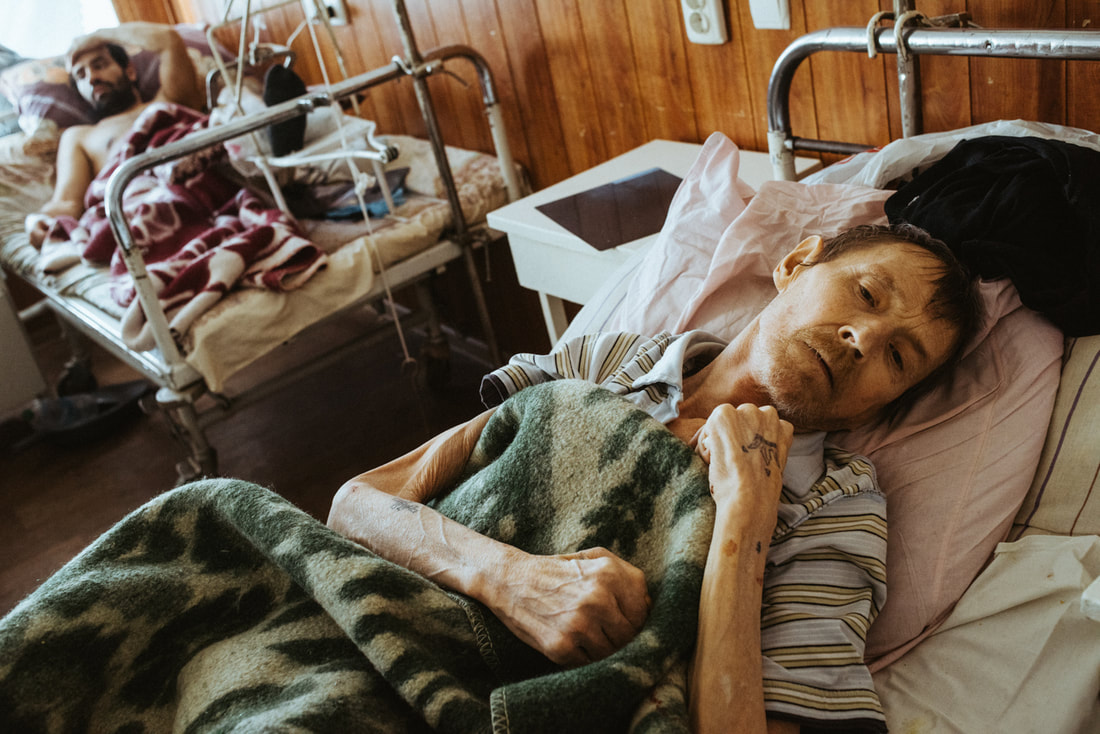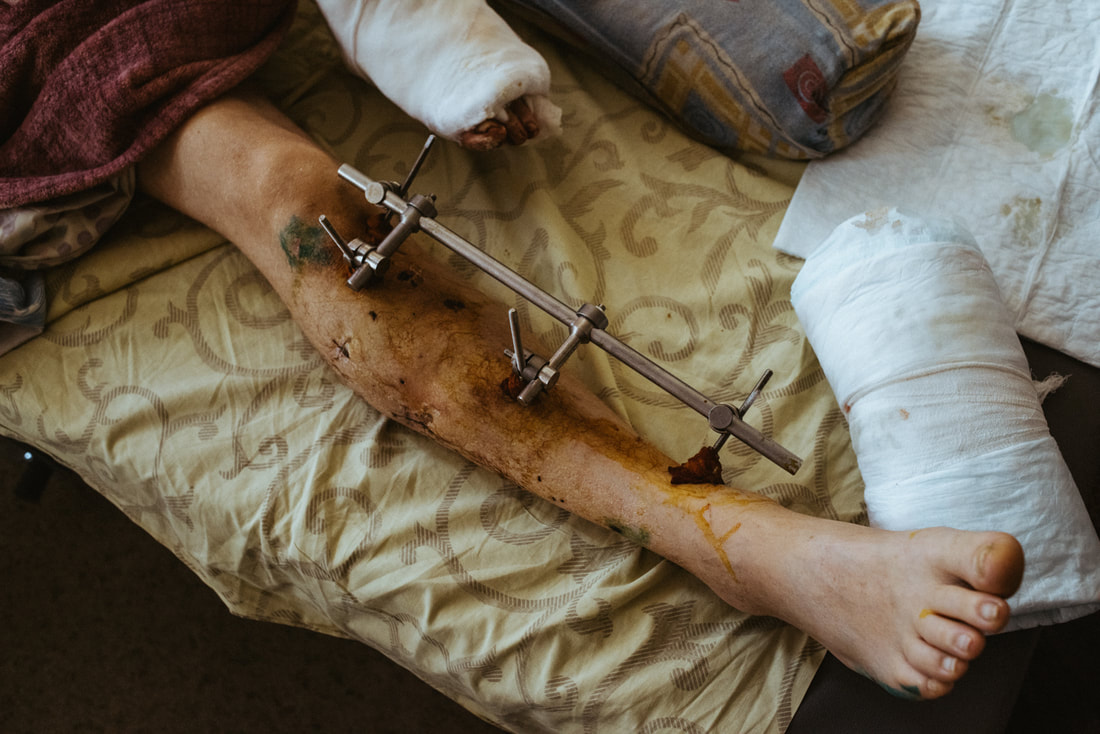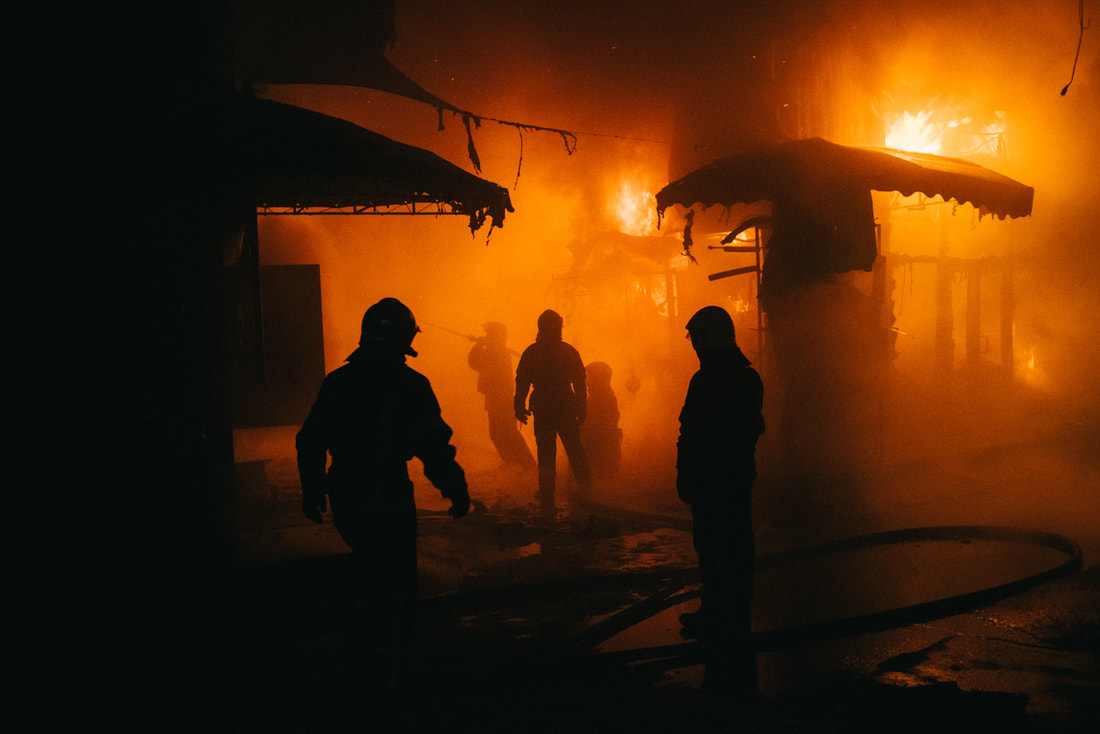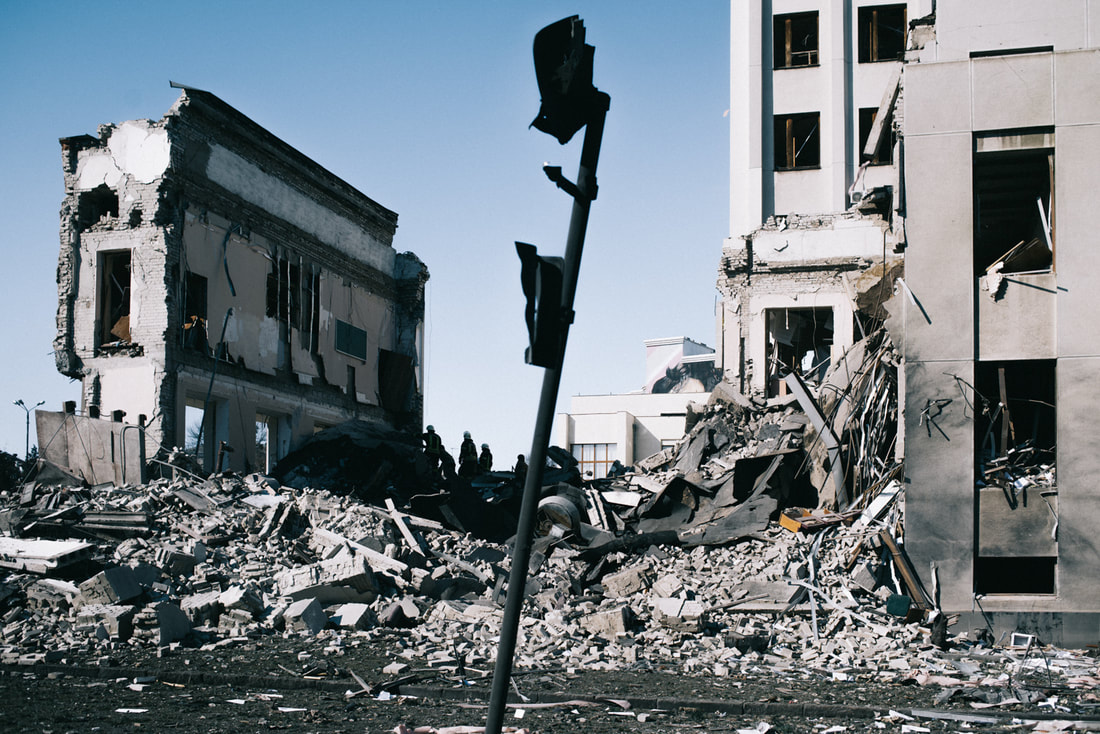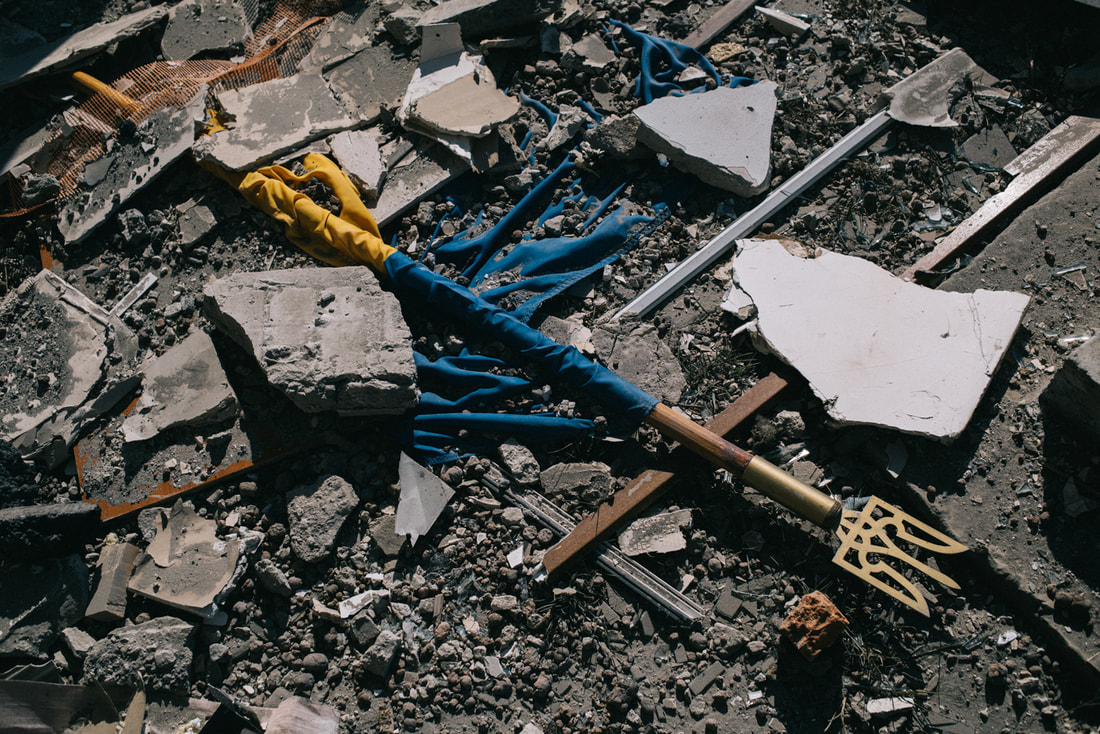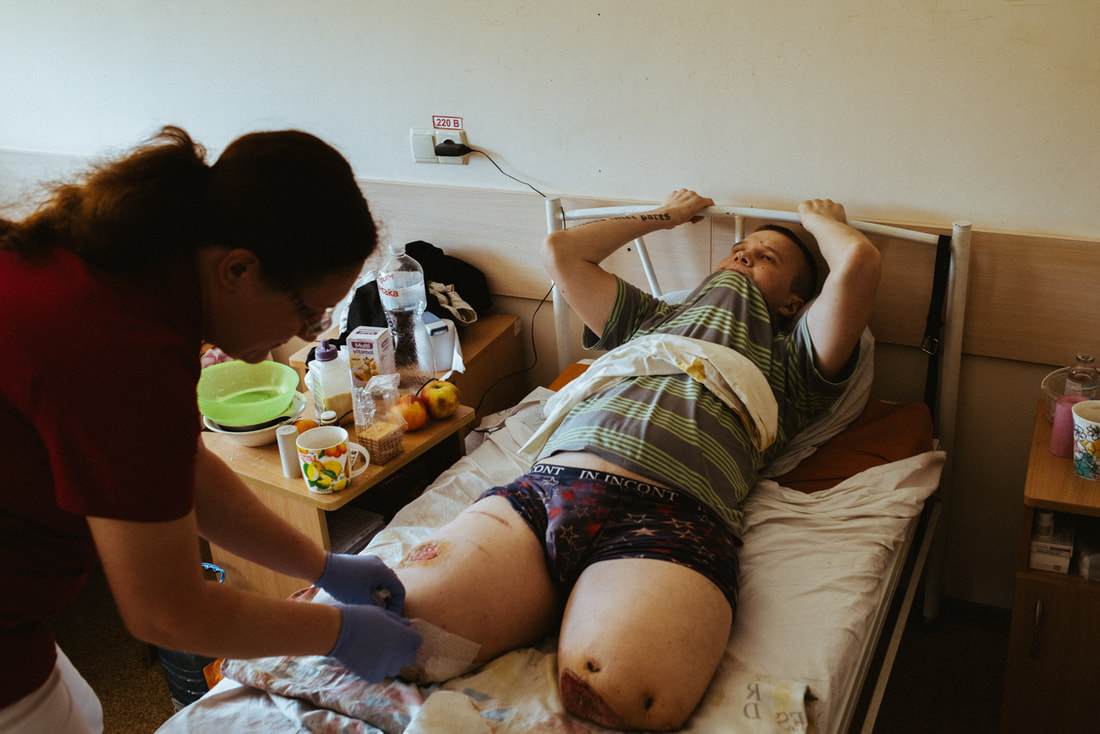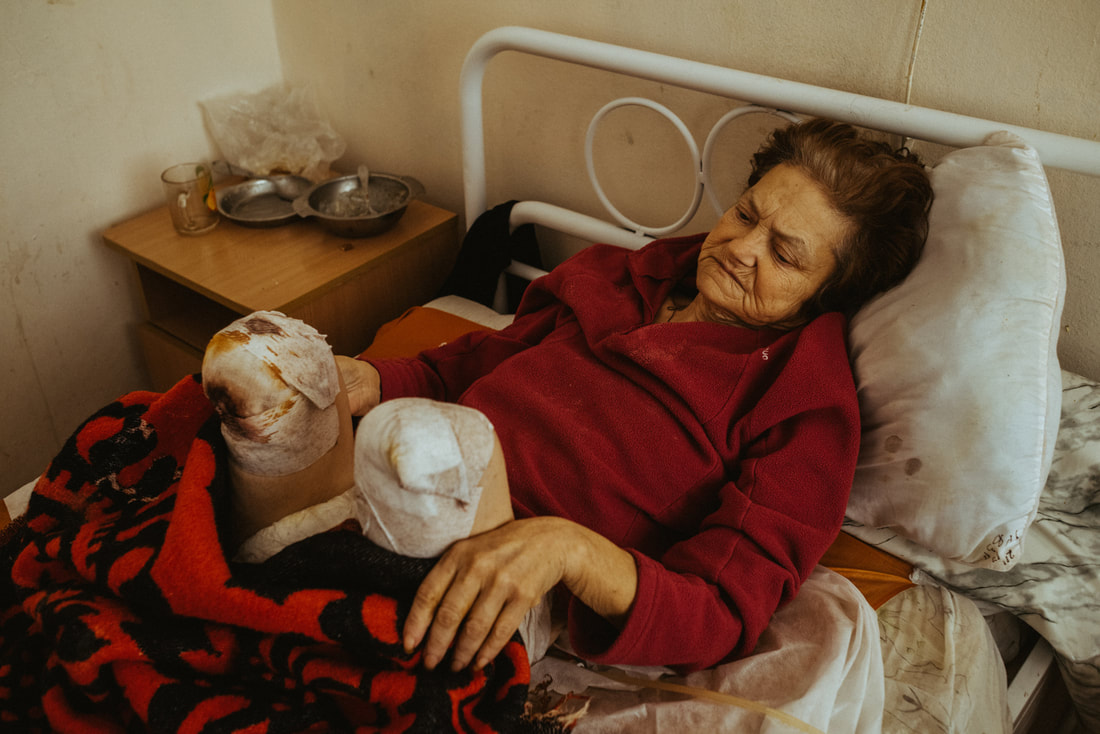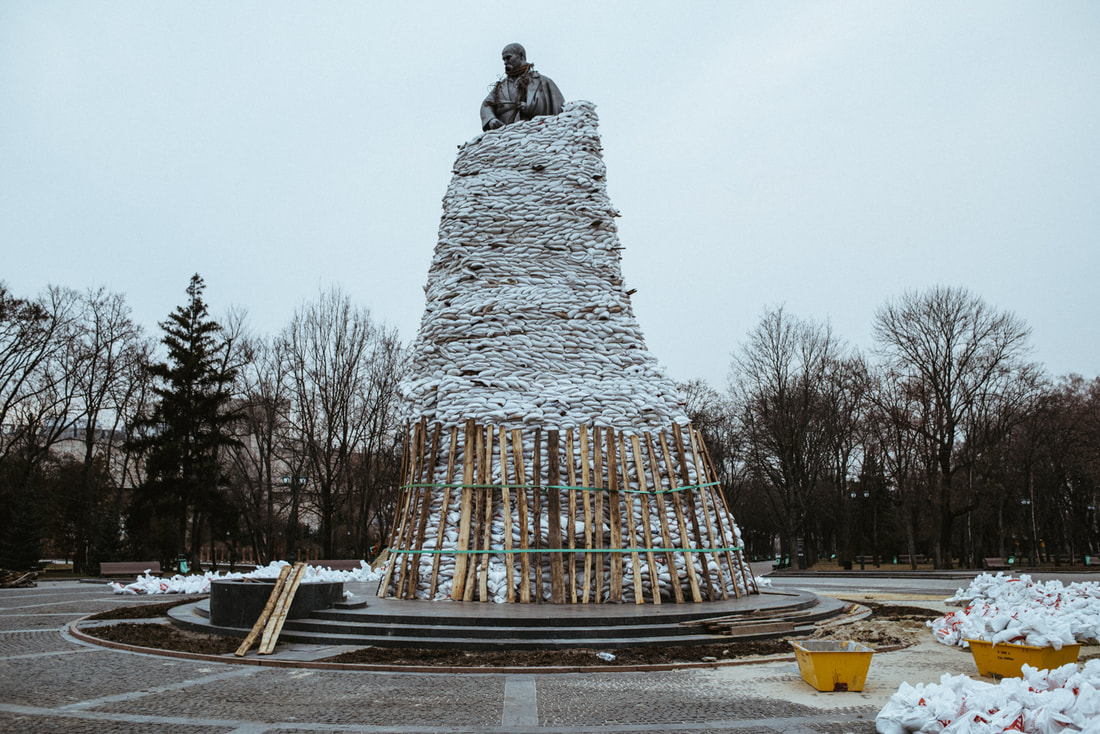This photo essay contains graphic images. The interview has been edited for length and clarity.
|
|
About the PhotographerMaxim Dondyuk is a Ukrainian visual artist working in the field of documentary photography. His practice integrates multiple mediums including photography, video, text, and archival material. Dondyuk's works often explore issues relating to history, memory, conflict, and their consequences. He has been widely awarded numerous recognitions including International Photographer of the Year in the Lucie Awards, finalist of the Prix Pictet Photography Prize, Magnum Photos competition ‘30 under 30’ for emerging documentary photographers, and finalist of the W. Eugene Smith Grant in Humanistic Photography. |
|
Photographers Maxim Dondyuk and Matthias Bruggmann are currently in Ukraine, photographing the Russian invasion. Alan Govenar (Truth in Photography) and Kristen Gresh (Truth in Photography guest curator, Estrellita and Yousuf Karsh Senior Curator of Photographs, Museum of Fine Arts, Boston) spoke with them and Maxim's wife, Irina Dondyuk, via Zoom on March 27, 2022.
Alan Govenar: We live in a world where people are so hungry for truth. They want to know what's really happening. Does photography have that power to sensitize people to realize not only the truth of what's going on in the world, but maybe something about themselves?
|
Maxim Dondyuk: Yeah, in my opinion, yes, especially if we speak about Russia. Because it's not a problem only of Putin, they have had big support from Russian citizens. It's not possible to make war against another country without support. A lot of Russian people hate Ukraine and think this is not a country at all, just a part of Russia. And Russian propaganda plays a big role in it. Russian people see a picture from Ukraine, which looks like Russia. They see many similarities between our countries, cities, people, children, and soldiers. And when they see wounded children, people without legs, completely destroyed buildings that look like their houses, I think in some way it can help to change the minds of some Russians. When they see war pictures from Syria or Iraq, it feels far away from them. But Kyiv architecturally is much closer to them, and I think they might realize something, even if it's too hard. Their brains are full of Russia Today or other propaganda media because Russian propaganda is really strong and powerful.
|
Govenar: It’s very complicated. In terms of what you're doing, what role do you think photography can have?
Dondyuk: Firstly, I try to find a place. Yesterday, I went to the hospital in Kharkiv. There were so many people without legs, injured people. It's too hard to see. Among them was a young man, 27 years old, without two legs. At the moment of the shelling, he was just sleeping in their house. And I felt… I mostly cry. Even for me, I’ve seen a lot of bad situations, but I feel a lot of emotions. I think it's very important for a documentarian because if photographers don't care about the situation and feel nothing, then their pictures can have very good compositions, but these will be dead pictures. Everything is okay, but no feeling. I try to put my feelings and my emotions in the pictures. When I was in Irpin, a small city near Kyiv, and the shelling started, I was afraid for the people who were evacuated from the city. I took these pictures while being afraid, and the people were also afraid and scared. I believe that if people see these pictures, they may also feel the same emotions. I try to be close with people. If it's a happy moment, I am happy. If it's a sad moment, I am also sad. Empathy is very important for documentary photography. I try to share not only how it looks, but also what people feel during the moment. And I think documentary photography can do it.
Dondyuk: Firstly, I try to find a place. Yesterday, I went to the hospital in Kharkiv. There were so many people without legs, injured people. It's too hard to see. Among them was a young man, 27 years old, without two legs. At the moment of the shelling, he was just sleeping in their house. And I felt… I mostly cry. Even for me, I’ve seen a lot of bad situations, but I feel a lot of emotions. I think it's very important for a documentarian because if photographers don't care about the situation and feel nothing, then their pictures can have very good compositions, but these will be dead pictures. Everything is okay, but no feeling. I try to put my feelings and my emotions in the pictures. When I was in Irpin, a small city near Kyiv, and the shelling started, I was afraid for the people who were evacuated from the city. I took these pictures while being afraid, and the people were also afraid and scared. I believe that if people see these pictures, they may also feel the same emotions. I try to be close with people. If it's a happy moment, I am happy. If it's a sad moment, I am also sad. Empathy is very important for documentary photography. I try to share not only how it looks, but also what people feel during the moment. And I think documentary photography can do it.
Govenar: I think that the truth ultimately is a feeling. It's not a visual reality, necessarily, it can be expressed in the visual world, but it’s a feeling that we have, and I think that what you're talking about there is very important in terms of this idea of empathy. In photographs about conflict, there’s this tension, and there's this tipping point between being a voyeur and being engaged. There’s an ethical process. How does that work for you? What do you think about it? Do you feel there are certain things that should not be photographed? Is everything open to be documented?
Dondyuk: It depends on the situation, but sometimes if I see somebody who needs my help - someone wounded, an old woman who needs help with her luggage, etc. - I will help first. I don't care about photography at this moment because first, I'm human, and second, I am a photographer. Of course, I document everything, even dead bodies, but it doesn’t mean I show everything. Maybe I will not show these pictures, but for me, it's very necessary to collect every moment for the future because now I cannot understand what's important, what's not. If I see something, I try to document it.
Govenar: Irina, how do these photographs that Maxim brings home affect you?
Irina Dondyuk: Some of them are really hard to look at. The dead bodies or those who are seriously wounded. The people who are in hospitals or the destroyed cities. Of course, I remember those cities as they were in good times. And of course, for me as a Ukrainian, it's very difficult because I see what my people feel. I feel the same even if I didn't need to flee. I didn't have a house that was destroyed, but still, I'm feeling the same pain. Sometimes I couldn't stop crying because all these photos are really difficult for me. I receive a lot of messages from other people who saw Maxim’s photos, and they also say that they can hardly stop crying looking at them.
Dondyuk: It depends on the situation, but sometimes if I see somebody who needs my help - someone wounded, an old woman who needs help with her luggage, etc. - I will help first. I don't care about photography at this moment because first, I'm human, and second, I am a photographer. Of course, I document everything, even dead bodies, but it doesn’t mean I show everything. Maybe I will not show these pictures, but for me, it's very necessary to collect every moment for the future because now I cannot understand what's important, what's not. If I see something, I try to document it.
Govenar: Irina, how do these photographs that Maxim brings home affect you?
Irina Dondyuk: Some of them are really hard to look at. The dead bodies or those who are seriously wounded. The people who are in hospitals or the destroyed cities. Of course, I remember those cities as they were in good times. And of course, for me as a Ukrainian, it's very difficult because I see what my people feel. I feel the same even if I didn't need to flee. I didn't have a house that was destroyed, but still, I'm feeling the same pain. Sometimes I couldn't stop crying because all these photos are really difficult for me. I receive a lot of messages from other people who saw Maxim’s photos, and they also say that they can hardly stop crying looking at them.
Dondyuk: It's difficult for me also. I’m a man, and I try to be strong, but sometimes when I see these crazy scenes, I can hardly stop tears, because I imagine what Putin can do – it looks like genocide. They want to just kill everybody, destroy our country, our language, our culture, and change our history, and sometimes I’m so upset about it. It's too hard psychologically… I try to change minds, and maybe somebody needs to see it, but it maybe makes big psychological problems for other people.
Govenar: That’s a big consideration. In terms of the process that you go through making a photograph, are you thinking consciously about composition? What is your point of focus?
Dondyuk: My camera is just a continuation of my eyes. I try to feel the moment, to capture this moment, to document it. It’s all automatic now. I think about pictures during selection, but not during shooting. I'm not sure if a boxer thinks about how he should kick someone. So it’s the same situation. Sometimes I forget about the camera. It is just a continuation of my body and my eyes. One writes a diary of his thoughts, and I have my own visual diary. I capture important moments for me, very sensitive moments. It's not about composition or something else.
Govenar: That’s a big consideration. In terms of the process that you go through making a photograph, are you thinking consciously about composition? What is your point of focus?
Dondyuk: My camera is just a continuation of my eyes. I try to feel the moment, to capture this moment, to document it. It’s all automatic now. I think about pictures during selection, but not during shooting. I'm not sure if a boxer thinks about how he should kick someone. So it’s the same situation. Sometimes I forget about the camera. It is just a continuation of my body and my eyes. One writes a diary of his thoughts, and I have my own visual diary. I capture important moments for me, very sensitive moments. It's not about composition or something else.
Govenar: How about you, Matthias? You were talking before Maxim and Irina came on about how you're not happy with the work that you've been doing.
Matthias Bruggmann: Yeah. I'm not. I think there's a set of reasons. The first, I absolutely don't have the knowledge of the country that Maxim does. I'm looking at the situation and I'm very overwhelmed by it, obviously. Where can I find a thread to start pulling on? It's been my question from the start. The feeling to me is a lot. It's a little bit less now that the pressure on Kiev is a little bit lower. But especially in the early days, I had a strong unsettling sense of being in two separate times simultaneously, where you could see this beautiful city that I'd been to once 15 years ago and at the same time, a very probable future of destruction. And that was very, very, very strange. The city was completely empty, or almost empty. And you're walking around, and you can almost see what it's going to look like after the Russians come in and it's shelled to the ground. But again, I still don't know where to start with what's happening. And I don't know if I'll be able to find even a place to start, is where I’m at.
Govenar: What compelled you to want to come?
Bruggmann: Well, it's interesting… there's one thing that I know how to do a little bit, which is to operate in environments like this. So, if there's going to be a situation like this, I'm one of the people who knows how to navigate it a little bit better than your average Joe. If what's about to happen is going to happen, this is a place where maybe I can be of use a little bit. Let me get a plane ticket and see if there's a way to tell the story. It’s hard to explain it.
Kristen Gresh: Matthias and I spoke recently about storytelling and conflict in a larger sense, evoking the many layers and different perspectives and techniques. I agree with Maxim on the importance of empathy and believe that the strongest documentary photography stems from a photographer’s empathy for their subject. The other day, Maxim, you said, “Matthias, you're going to leave here. I'm here. This is my home.” To me, this is an important distinction. As you mentioned, Matthias, this idea that you are coming in with a different point of view, and you don't have the knowledge of the country and are learning about it versus Maxim’s deep knowledge of his country and culture. These two different – both essential – perspectives each play valuable roles in documenting this situation.
Dondyuk: I think for Matthias or another international photographer, in some way it's easier to cover this conflict, because I’m just from one side, I’m from a pro-Ukrainian side/view. An international photographer can go to another side and see how it looks from the Russian side, because sometimes that also might be important. I don't know. Maybe some photographers come to Ukraine because they want to see this small country that confronts Russia, this strong and big country, that was supposed to occupy Ukraine in three days. But it did not happen and now everybody's interested. What is this country? Who are these people fighting so bravely?
Matthias Bruggmann: Yeah. I'm not. I think there's a set of reasons. The first, I absolutely don't have the knowledge of the country that Maxim does. I'm looking at the situation and I'm very overwhelmed by it, obviously. Where can I find a thread to start pulling on? It's been my question from the start. The feeling to me is a lot. It's a little bit less now that the pressure on Kiev is a little bit lower. But especially in the early days, I had a strong unsettling sense of being in two separate times simultaneously, where you could see this beautiful city that I'd been to once 15 years ago and at the same time, a very probable future of destruction. And that was very, very, very strange. The city was completely empty, or almost empty. And you're walking around, and you can almost see what it's going to look like after the Russians come in and it's shelled to the ground. But again, I still don't know where to start with what's happening. And I don't know if I'll be able to find even a place to start, is where I’m at.
Govenar: What compelled you to want to come?
Bruggmann: Well, it's interesting… there's one thing that I know how to do a little bit, which is to operate in environments like this. So, if there's going to be a situation like this, I'm one of the people who knows how to navigate it a little bit better than your average Joe. If what's about to happen is going to happen, this is a place where maybe I can be of use a little bit. Let me get a plane ticket and see if there's a way to tell the story. It’s hard to explain it.
Kristen Gresh: Matthias and I spoke recently about storytelling and conflict in a larger sense, evoking the many layers and different perspectives and techniques. I agree with Maxim on the importance of empathy and believe that the strongest documentary photography stems from a photographer’s empathy for their subject. The other day, Maxim, you said, “Matthias, you're going to leave here. I'm here. This is my home.” To me, this is an important distinction. As you mentioned, Matthias, this idea that you are coming in with a different point of view, and you don't have the knowledge of the country and are learning about it versus Maxim’s deep knowledge of his country and culture. These two different – both essential – perspectives each play valuable roles in documenting this situation.
Dondyuk: I think for Matthias or another international photographer, in some way it's easier to cover this conflict, because I’m just from one side, I’m from a pro-Ukrainian side/view. An international photographer can go to another side and see how it looks from the Russian side, because sometimes that also might be important. I don't know. Maybe some photographers come to Ukraine because they want to see this small country that confronts Russia, this strong and big country, that was supposed to occupy Ukraine in three days. But it did not happen and now everybody's interested. What is this country? Who are these people fighting so bravely?
Govenar: I think the number of photographers to me is important, because having grown up through the Vietnam War era, that war was so documented, and it was ultimately the photographs that helped drive the dialogue. It made it apparent that it needed to be over. And when the United States went into Iraq, there was radio silence. Very few visuals. Tens of thousands of Iraqis being obliterated, like what's happening in the Ukraine, but there's no real visual record of that. Do you feel you have a responsibility to depict this, what's happening, as accurately as you can?
Dondyuk: I don't know if it's a responsibility, but I need to do it because I am a documentary photographer. I’m not a war photographer, I don't want to continue my career as a war photographer. I started documenting war only because it happened in my country. Only because Russia tried to occupy my country. But everybody now tries to resist the Russian invasion. Some people go into the army and territorial defense, others help as volunteers. For me, it's very important to document this story, this historical moment. It’s my weapon. I can fight against the Russian propaganda. I can capture this moment, capture these emotions for the next generations or for people who are far away from Ukraine, because people should know what’s going on here. It's very important to see how it looks, because Russia can say, “No, we're not bombing the cities and hospitals are not destroyed,” but if you see a picture, you do not need any words. You just see dead people. You see people without legs. You see destroyed buildings. So it's very important. I don’t see it as my responsibility, I just do it.
Govenar: It sounds like it deeply affects you. Do you have trouble sleeping at night?
Dondyuk: You mean nightmares or what?
Govenar: When you go into these situations, so much of what you're looking at and photographing, it's horrific. Does it haunt you?
Dondyuk: I sleep now, like a child. I have never covered happy situations. So I have nightmares all the time, but it's not because of the war. But now, if I go to sleep, I sleep perfectly well, even if there are bombings outside. From the day this war started, I mostly sleep 3-4 hours per day. So if I have time, I just sleep. I think I put all my emotions into the pictures. I don’t try to keep it by myself. I see something and I have a visual container and put all my emotions in this container. If I want to cry, I try to put this feeling into the picture and people maybe will see this picture and feel the sad situation.
Dondyuk: I don't know if it's a responsibility, but I need to do it because I am a documentary photographer. I’m not a war photographer, I don't want to continue my career as a war photographer. I started documenting war only because it happened in my country. Only because Russia tried to occupy my country. But everybody now tries to resist the Russian invasion. Some people go into the army and territorial defense, others help as volunteers. For me, it's very important to document this story, this historical moment. It’s my weapon. I can fight against the Russian propaganda. I can capture this moment, capture these emotions for the next generations or for people who are far away from Ukraine, because people should know what’s going on here. It's very important to see how it looks, because Russia can say, “No, we're not bombing the cities and hospitals are not destroyed,” but if you see a picture, you do not need any words. You just see dead people. You see people without legs. You see destroyed buildings. So it's very important. I don’t see it as my responsibility, I just do it.
Govenar: It sounds like it deeply affects you. Do you have trouble sleeping at night?
Dondyuk: You mean nightmares or what?
Govenar: When you go into these situations, so much of what you're looking at and photographing, it's horrific. Does it haunt you?
Dondyuk: I sleep now, like a child. I have never covered happy situations. So I have nightmares all the time, but it's not because of the war. But now, if I go to sleep, I sleep perfectly well, even if there are bombings outside. From the day this war started, I mostly sleep 3-4 hours per day. So if I have time, I just sleep. I think I put all my emotions into the pictures. I don’t try to keep it by myself. I see something and I have a visual container and put all my emotions in this container. If I want to cry, I try to put this feeling into the picture and people maybe will see this picture and feel the sad situation.
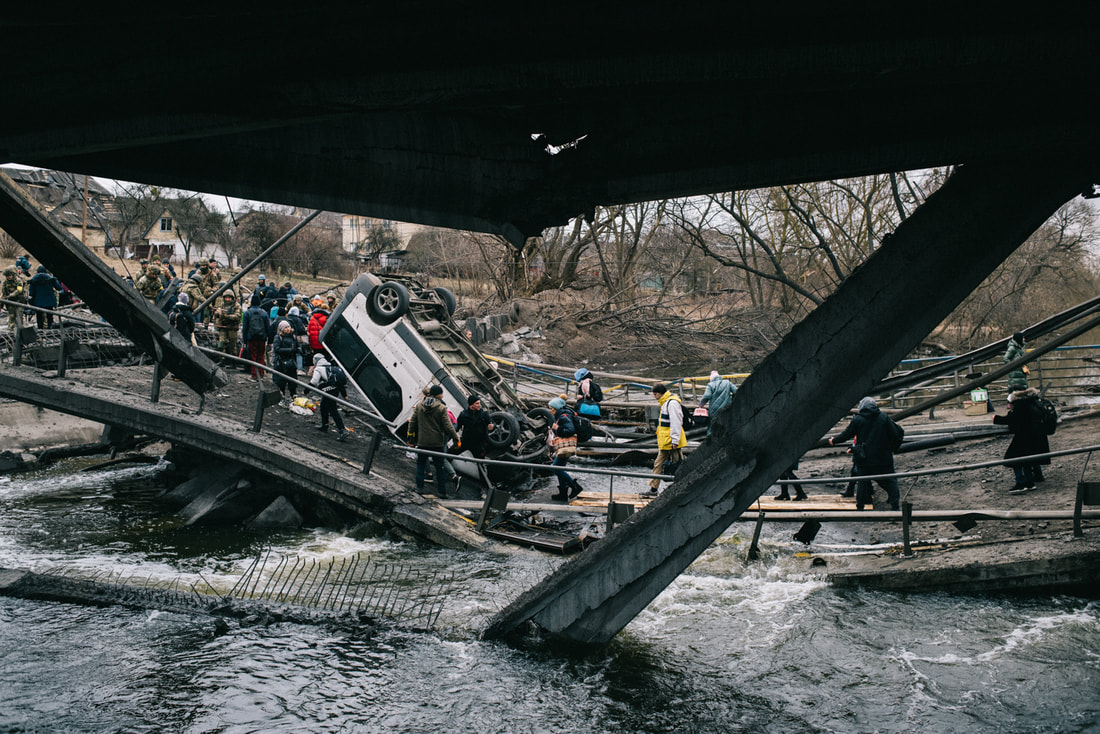
Evacuation of civilians from the town of Irpin, through a bridge destroyed by the Armed Forces of Ukraine to prevent the enemy from reaching Kyiv. On this day at 10 a.m. women, children, and the elderly were supposed to be evacuated from the town by trains, but Russian forces blew up the railroad tracks, and so people were asked to move to another place, where they will be picked up by buses for transportation to the Kyiv railway station. Irpin town, Kyiv region, Ukraine, March 5, 2022. © Maxim Dondyuk / Der Spiegel
Govenar: How about you, Matthias, how does this affect you personally?
Bruggmann: In many ways, I'm very pessimistic about the power of photography currently, what you were saying about Iraq in some ways. I mean, I disagree with you. And it's also something that kind of applies here. I don't think that it's as much a lack of coverage because there was coverage in Iraq of what was happening in terms of the civilians. I was part of a group that snuck in and spent the war taking pictures of refugees, of what was happening to Iraqi civilians in the south. Here, there’s two or three thousand journalists in Kiev and I think eight hundred in Lviv, but you don't have any in Mariupol. Maybe Maxim would know if there's anyone in Chernihiv right now, which is going to be another major massacre. And so these things are going on completely undocumented at this point. There's an incredible work that was done by an AP team in Mariupol, but they had to pull out. And right now, the only people that are doing anything there are working on the Russian side. So that's obviously pretty problematic in terms of figuring out what's happening.
In terms of how it affects me personally, I've been fortunate not to suffer from the consequences of what I've seen as much as many of my friends have. One of the reasons why I come to things like this is that you feel like you're doing something, no matter how small. You're taking control and you're not just watching this horrific situation unfold in front of you completely powerless. These are obviously situations that affect all of us very, very deeply and very personally. And it's obviously something that I knew going in would affect me in the long term. It's not just about parachuting in and being here for a couple of weeks and then leaving.
Govenar: I think your point is well taken. I was being too general. But coming back to another point you made that I think is interesting, why do you have this pessimism about photography? Is it a visceral response? Is it an intellectual response?
Bruggmann: I think it's a little bit of both. It's a comfortable myth to believe that if we'd “known” it would have been “different.” And it's been repeated again and again and again. There's the one kind of outlier with Vietnam. But even that doesn't really hold up to scrutiny, where you can make a reading that what happened was thanks to the power of photography, but you can be a little bit more cynical and say, listen, it was mostly about the draft and about middle-class kids getting sent to the slaughter all of a sudden. These educated, rich kids who had to go there, and that becomes unacceptable, much more unacceptable than the pictures of dying civilians.
Bruggmann: In many ways, I'm very pessimistic about the power of photography currently, what you were saying about Iraq in some ways. I mean, I disagree with you. And it's also something that kind of applies here. I don't think that it's as much a lack of coverage because there was coverage in Iraq of what was happening in terms of the civilians. I was part of a group that snuck in and spent the war taking pictures of refugees, of what was happening to Iraqi civilians in the south. Here, there’s two or three thousand journalists in Kiev and I think eight hundred in Lviv, but you don't have any in Mariupol. Maybe Maxim would know if there's anyone in Chernihiv right now, which is going to be another major massacre. And so these things are going on completely undocumented at this point. There's an incredible work that was done by an AP team in Mariupol, but they had to pull out. And right now, the only people that are doing anything there are working on the Russian side. So that's obviously pretty problematic in terms of figuring out what's happening.
In terms of how it affects me personally, I've been fortunate not to suffer from the consequences of what I've seen as much as many of my friends have. One of the reasons why I come to things like this is that you feel like you're doing something, no matter how small. You're taking control and you're not just watching this horrific situation unfold in front of you completely powerless. These are obviously situations that affect all of us very, very deeply and very personally. And it's obviously something that I knew going in would affect me in the long term. It's not just about parachuting in and being here for a couple of weeks and then leaving.
Govenar: I think your point is well taken. I was being too general. But coming back to another point you made that I think is interesting, why do you have this pessimism about photography? Is it a visceral response? Is it an intellectual response?
Bruggmann: I think it's a little bit of both. It's a comfortable myth to believe that if we'd “known” it would have been “different.” And it's been repeated again and again and again. There's the one kind of outlier with Vietnam. But even that doesn't really hold up to scrutiny, where you can make a reading that what happened was thanks to the power of photography, but you can be a little bit more cynical and say, listen, it was mostly about the draft and about middle-class kids getting sent to the slaughter all of a sudden. These educated, rich kids who had to go there, and that becomes unacceptable, much more unacceptable than the pictures of dying civilians.
Govenar: Clément Chéroux writes a lot about the idea of the iconic photograph, how typically in conflict and war, there are certain images that continue to resonate through the generations. I think to do war photography, to some extent, you have to believe that change is possible. What’s your feeling on that, Maxim? Do you feel you can possibly make a difference? Do you feel hopeful at the end of the day?
|
Dondyuk: Before this conflict, I felt like Matthias. I think because I spent a lot of time covering a tuberculosis problem in Ukraine. It was too hard for me, and I just lost any hope that photography can change something. But it's not a problem of photography. You can document a situation. You can make visual evidence of a situation. It’s like 50/50 because I’ve started to believe that photography can change something only after TIME magazine used my picture on the cover. Because if some powerful media uses your picture, everybody knows it. Of course, if I shared this picture on my website or social media, it wouldn’t change anything. It’s collaboration. I can be here, I can document. Of course, I cannot change the world, but in collaboration with some organizations, some media, we can do something. If someone uses my picture, they can change minds. On both sides, even if I don't want to. Russian propaganda can use my picture with a different point of view, but for me, I was surprised about TIME because after this cover, everybody lost their minds. People called me, interviewed me, and everybody knew about this soldier, about this woman. A lot of magazines and TV made interviews and spread this story and people saw this, and Japanese people called me and cried when I explained about the child, the six-year-old who just lost father, mother, and sister when Russia started shelling and started a war against Ukraine. So now I'm not sure that it's not possible. But before I just was so pessimistic, like Matthias. So maybe it's collaboration. I can do something, but without proper support, it's just a picture.
|
Gresh: Going back to Alan’s question of the notion of responsibility, despite a certain pessimism that you both talk about, I sense – at the same time – an intense conviction from both of you. It is an interesting combination, right? It's pessimism, but it feels like there is a certain level of belief. Both of you make good points about specific stories related to how media vehicles operate. Editorial structures and networks are often invisible to the public because when viewers are processing and reacting to the cover of a magazine, for example, they don’t always know about the complexities or larger context of the photograph. We still haven't gotten away from the single story -- people are often just grabbing onto singular ideas without thinking beyond or about the context that has created the meaning of the photograph. That's one of the most interesting things to me about photojournalism – looking at all of those steps within it.
Bruggmann: You are talking a lot about responsibility, but I think that what's also very important is accountability, and that's one thing where photography still has a use to a degree. And hopefully that’s what we're seeing now. Where Maxim was shelled in Irpin was exactly the same spot as where Lynsey Addario witnessed a family getting killed a few hours earlier. And that says something about the Russians repeatedly hitting refugee columns. In Mariupol, the AP team that was pulled out, one of the fears that they talk about was that they were going to be captured by the Russians and then they'd be forced into saying that what they'd photographed wasn't what they represented it to be.
I think it's difficult to believe in the power of even a global cache of images when you see what little has been done thus far with the Caesar Archive in Syria, where you have literally tens of thousands of deaths that are documented by tens of thousands of images and that happened in real time. Probably the most important moments in this conflict haven’t gotten documented. We have allegedly thousands, if not tens of thousands of civilians that are being forcibly deported. We have thousands of deaths, most likely, of soldiers on both sides that absolutely haven't been documented. That says something. You have untold destruction. You have tens of thousands of pictures, probably, of five buildings in Kiev. And you have virtually no pictures of thousands of buildings in Mariupol and in [Turniv]. That's very concerning to me.
Dondyuk: Yeah, but Matthias, I disagree with you. I try to show how I see this war, and maybe I cannot take every picture, because what you’re saying is to collect every moment. It's too complicated. If you just show one destroyed building, it doesn't matter if it's Kharkiv, Kyiv, Mariupol, or Chernobyl, if you show one body without two legs or without arms, it doesn't matter where. If it’s Ukraine, it's enough. You shoot to make a strong, strong emotional picture and sometimes even ten pictures. It's enough. Of course, if we have access to Mariupol, it's better to go. But if we cannot, what can we do? But if we say photography cannot change minds, imagine in Ukraine, if you cannot see any pictures. How can people know what happened in Ukraine? Only the Russian propaganda on Russian TV, and we cannot see any pictures in Ukraine, even from mobile phones. It’s about truth, and Putin’s really afraid. The Russian Army tried to capture AP photographers in Mariupol, because they want to have them say on video, “I am a liar, blah blah blah. It's staged. It's not true.” So it depends. Maybe in Syria it doesn't work. I don't know, because now Putin and Russia lie and try to say and show a completely different situation, and they hate and are afraid of us who document a real situation. So even they understand we can change the minds of Russian people.
Bruggmann: You are talking a lot about responsibility, but I think that what's also very important is accountability, and that's one thing where photography still has a use to a degree. And hopefully that’s what we're seeing now. Where Maxim was shelled in Irpin was exactly the same spot as where Lynsey Addario witnessed a family getting killed a few hours earlier. And that says something about the Russians repeatedly hitting refugee columns. In Mariupol, the AP team that was pulled out, one of the fears that they talk about was that they were going to be captured by the Russians and then they'd be forced into saying that what they'd photographed wasn't what they represented it to be.
I think it's difficult to believe in the power of even a global cache of images when you see what little has been done thus far with the Caesar Archive in Syria, where you have literally tens of thousands of deaths that are documented by tens of thousands of images and that happened in real time. Probably the most important moments in this conflict haven’t gotten documented. We have allegedly thousands, if not tens of thousands of civilians that are being forcibly deported. We have thousands of deaths, most likely, of soldiers on both sides that absolutely haven't been documented. That says something. You have untold destruction. You have tens of thousands of pictures, probably, of five buildings in Kiev. And you have virtually no pictures of thousands of buildings in Mariupol and in [Turniv]. That's very concerning to me.
Dondyuk: Yeah, but Matthias, I disagree with you. I try to show how I see this war, and maybe I cannot take every picture, because what you’re saying is to collect every moment. It's too complicated. If you just show one destroyed building, it doesn't matter if it's Kharkiv, Kyiv, Mariupol, or Chernobyl, if you show one body without two legs or without arms, it doesn't matter where. If it’s Ukraine, it's enough. You shoot to make a strong, strong emotional picture and sometimes even ten pictures. It's enough. Of course, if we have access to Mariupol, it's better to go. But if we cannot, what can we do? But if we say photography cannot change minds, imagine in Ukraine, if you cannot see any pictures. How can people know what happened in Ukraine? Only the Russian propaganda on Russian TV, and we cannot see any pictures in Ukraine, even from mobile phones. It’s about truth, and Putin’s really afraid. The Russian Army tried to capture AP photographers in Mariupol, because they want to have them say on video, “I am a liar, blah blah blah. It's staged. It's not true.” So it depends. Maybe in Syria it doesn't work. I don't know, because now Putin and Russia lie and try to say and show a completely different situation, and they hate and are afraid of us who document a real situation. So even they understand we can change the minds of Russian people.
Bruggmann: I’ve had this discussion with leftist American friends of mine who, when we're showing them the simple day to day pictures, are looking at those pictures and are denying that that's what we're seeing, what we're showing them. Those crimes. You were talking earlier about the Russian public, the things that the Russian public has access to. Yes, now Facebook is blocked and Instagram's blocked. But they have access. They've got VPNs, especially the younger generation. They have access to know exactly what's happening. Yet, they support the invasion of Ukraine. They've seen what's happening, that's what’s scary to me. It was the same with Syria, you have people that have been shown again and again and again and again what's happening, and they're looking at you in the eye and they're going, “I don't care.” This is the reality that we're fighting against.
Dondyuk: We cannot change minds in a second… It's step by step and they will just see more and more and more. I just think it's a big conversation.
Bruggmann: Just to be really clear, I’m absolutely not suggesting that the answer’s to give up. There’s this old joke that democracy is the worst system in the world, except every other system. And in a way, I think documentary photography kind of works like that. It's the worst fucking thing in the world, except everything else we can do about it, to document it.
Gresh: I think often when we talk about war photography or conflict photography, we think about it coming from where the conflict or war is happening and how the people outside of the country perceive it. But in this situation I wonder, what is the role, if any, of photography for the Ukrainian resistance? What is the impact of the images there in Ukraine?
Dondyuk: It’s maybe not an impact, it’s just spreading information. It’s about showing this situation. I do not believe in TV because TV, for me, is without feeling. I think photography has more emotions. Photography is between reality and art; you can feel a lot of emotion. Sometimes it's a very sad situation, but a beautiful one, like art paintings. When we go to a museum, there are a lot of paintings about war, revolution, dead people. It's not about just perfect moments. It's just beautiful, but sometimes very sad moments. And we remember it because it's a really strong picture. With video sometimes we'll see some people killed, but we forget about this video because we need some icon. We need some iconic picture and photography is much stronger than video. When you just see a video, and the next video, and after that some funny cat, you forget about the dead people in the previous video. But if you see a picture, sometimes it impacts you and you cannot forget. It's like good movies and good books. If we can speak about moments, it’s about pictures because video is not a still picture. And if we want to stop one moment, it's about a picture.
Dondyuk: We cannot change minds in a second… It's step by step and they will just see more and more and more. I just think it's a big conversation.
Bruggmann: Just to be really clear, I’m absolutely not suggesting that the answer’s to give up. There’s this old joke that democracy is the worst system in the world, except every other system. And in a way, I think documentary photography kind of works like that. It's the worst fucking thing in the world, except everything else we can do about it, to document it.
Gresh: I think often when we talk about war photography or conflict photography, we think about it coming from where the conflict or war is happening and how the people outside of the country perceive it. But in this situation I wonder, what is the role, if any, of photography for the Ukrainian resistance? What is the impact of the images there in Ukraine?
Dondyuk: It’s maybe not an impact, it’s just spreading information. It’s about showing this situation. I do not believe in TV because TV, for me, is without feeling. I think photography has more emotions. Photography is between reality and art; you can feel a lot of emotion. Sometimes it's a very sad situation, but a beautiful one, like art paintings. When we go to a museum, there are a lot of paintings about war, revolution, dead people. It's not about just perfect moments. It's just beautiful, but sometimes very sad moments. And we remember it because it's a really strong picture. With video sometimes we'll see some people killed, but we forget about this video because we need some icon. We need some iconic picture and photography is much stronger than video. When you just see a video, and the next video, and after that some funny cat, you forget about the dead people in the previous video. But if you see a picture, sometimes it impacts you and you cannot forget. It's like good movies and good books. If we can speak about moments, it’s about pictures because video is not a still picture. And if we want to stop one moment, it's about a picture.
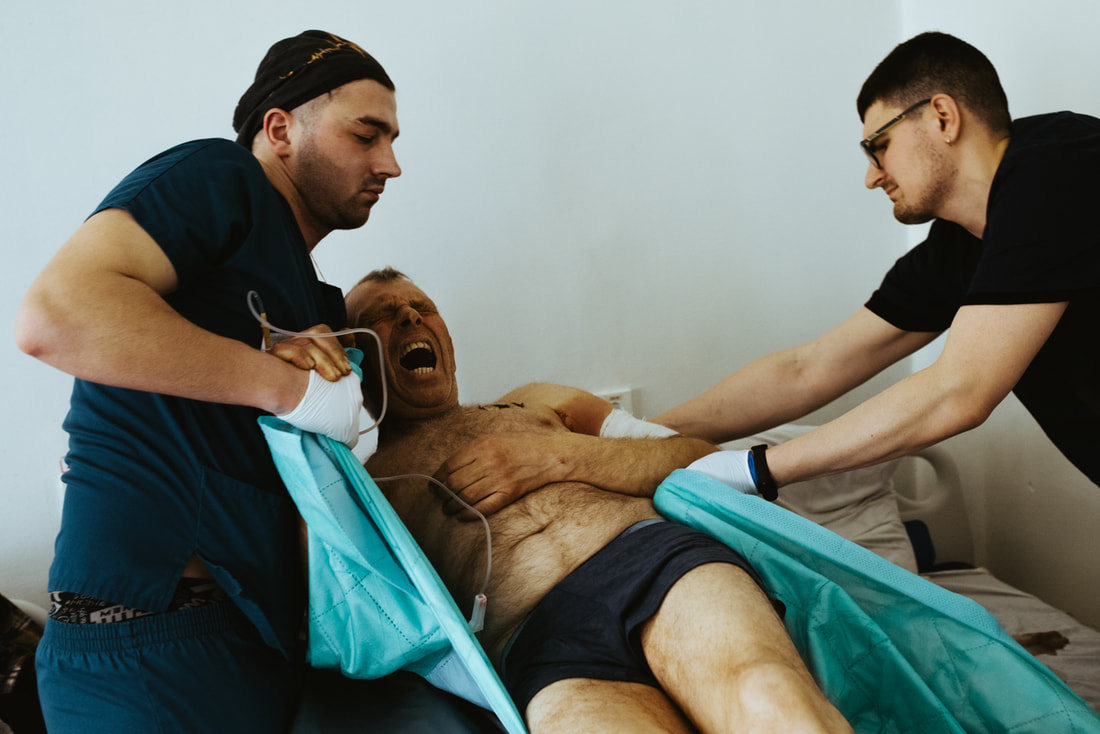
Sergiy, 56 years old, got to the hospital with a very serious injury to his hand. The wound had already been infected and began to stink. He was wounded two days earlier, but because of the mass shelling of his city near Kharkov, none of the doctors could arrive in the city. One of his neighbors made him a dressing without medicine or anesthetic. He spent two days in the basement under constant shelling, before he was brought to the hospital. According to doctors, the situation is very complicated. Regional Hospital of Kharkiv, March 27, 2022. © Maxim Dondyuk / Der Spiegel
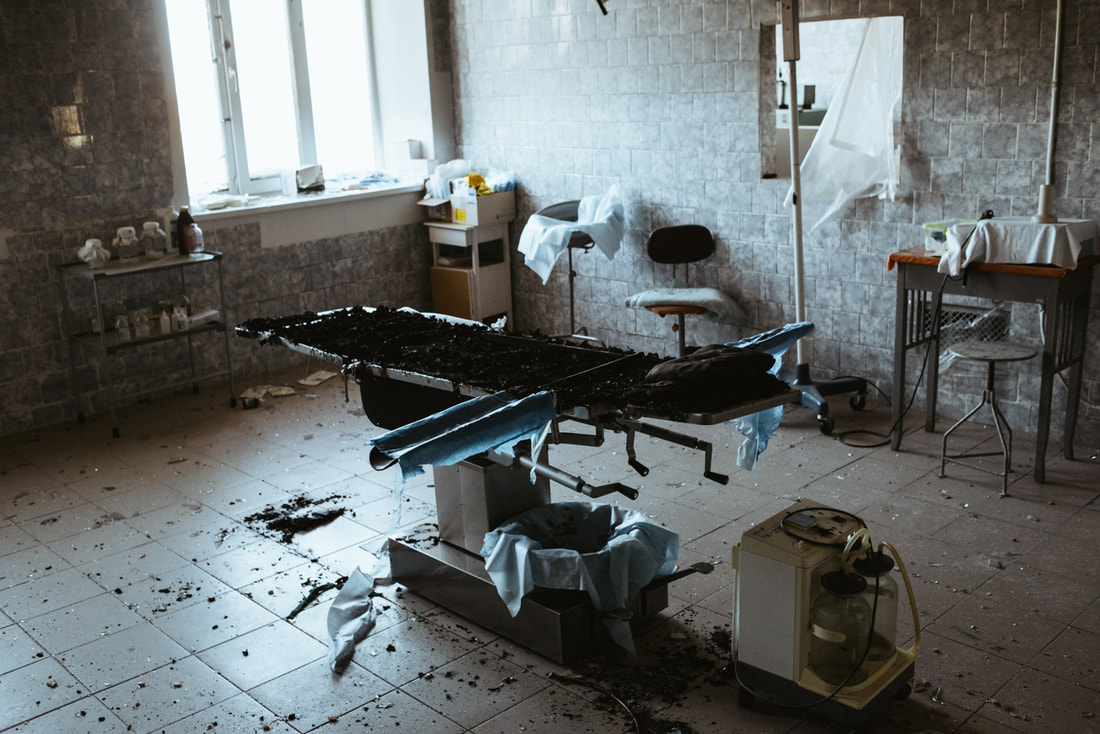
The new polyclinic, which was completely reconstructed and modernized only half a year ago, was shot from a tank during the time of occupation by Russian troops. One of the shells hit the maternity department, where there were women with children. The reason for the shelling is unknown, since the military was not there. Trostyanets, Sumy region, March 29, 2022. © Maxim Dondyuk / Der Spiegel
|
|
|

